Trip Journal: April 27 - May 4, 2022
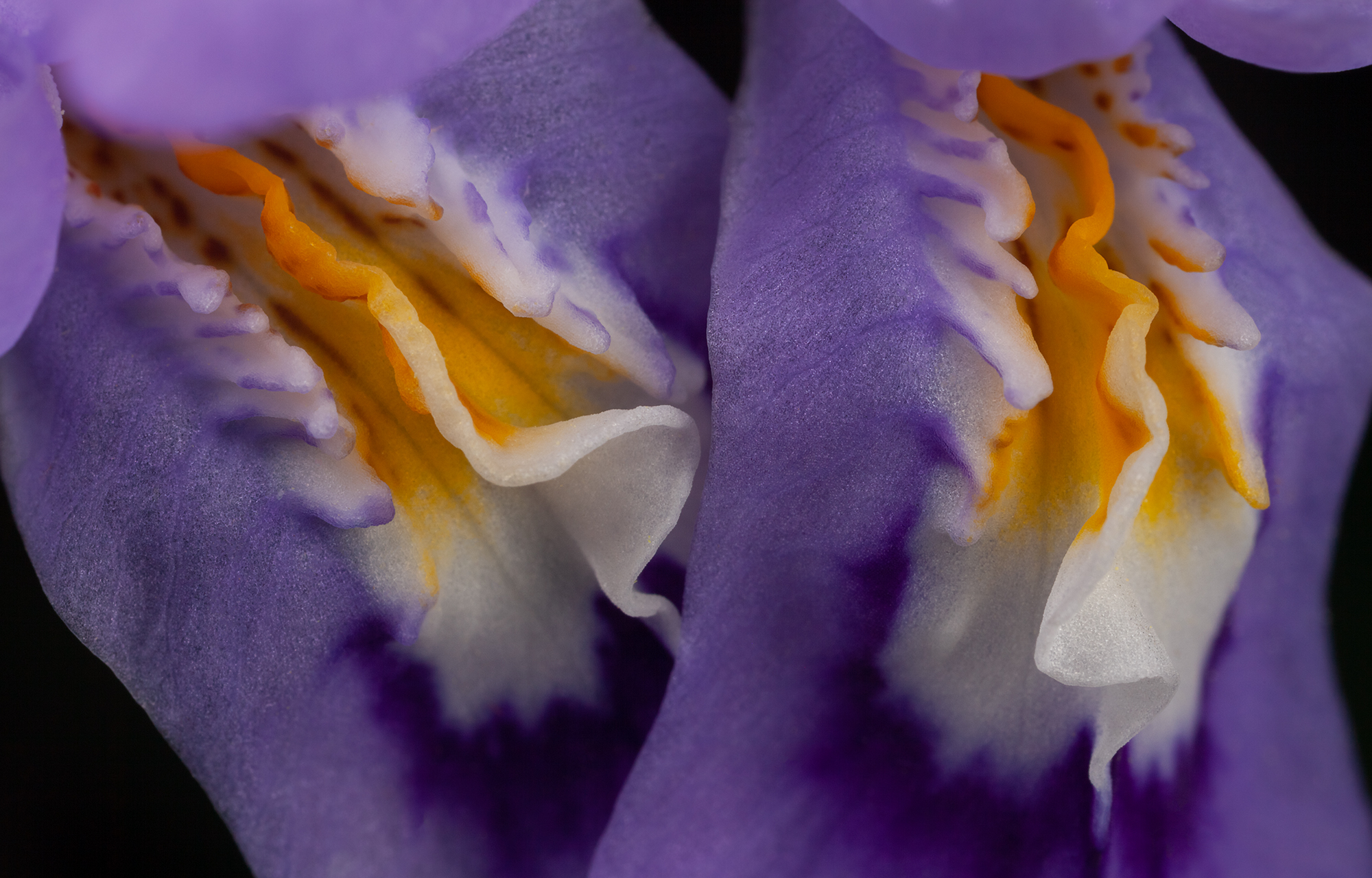
I’m a photo naturalist. That is, I use the camera as a tool to learn about the natural world, specifically the land. My aim is to capture the spirit of discovery–the curiosity, the excitement, and the connection to–place that I find through my own outdoor adventures.
I had some great conversations with a friend last week regarding why we photograph. My friend had recently attended a photography workshop out west and generously shared the philosophy of the group leader with me. Without getting too deep into the weeds, the workshop leader stated that, ultimately, he photographs to attain creative flow.
I don’t photograph to experience creative flow. Or perhaps I do, but my brand of creative flow is less about art and more about a feeling of connection. I photograph the natural world to develop greater connection with the land. This happens, for me, through experiential learning. I’m as anamored with the state of creative flow as anyone. It’s not my goal, however. Just a beautiful result from time to time, not unlike happiness in that way. Perhaps with a term as purposefully ambiguous as creative flow, connection with the land is my flow?
I first came across the philosophy of a photo naturalist through Tony Wu. Tony is an amazing underwater photographer with a great intellect and capacity for words. While almost every photographer in my orbit is servicing art and artistic ideals as the highest purpose of the camera, Tony’s using art (through the camera) to attain greater knowledge. Art is the game, yes. But, it’s not the purpose. Not the why. Art is the vehicle to something greater. And while I realize this is all nuance, I believe it’s also important.
I treat my own photographs more like entries into a journal or a sketchbook than I do fine art pieces on a wall. My photos are not precious. None are perfect. Many are simply incomplete ideas, imperfect and awaiting further exploration. My photos are not surreal, fantastical, or otherworldly (dreamscapes). They don’t represent artistic statements. My photographs do represent, instead, a curiosity explored through an artistic medium. My connection with the land through art and through physical movement is why I truly do this.
I believe we all pick up a camera for different reasons. There is no one reason why. And that’s a good thing. The differences are where interest is found.
Day seven: April 27, 2022
I feel worn down. When I’m contracted for a photography adventure, I know that time is the scarce resource. My client only has a certain number of days and my desire is to make sure that he/she gets to see and do as much as possible during that time. Together, we often reinforce each others’ efforts, pushing the other (and the experience) forward further than either would individually. In that way, I often learn and experience more when I’m guiding than I might when I’m on my own time.
By the time I finish up my chores the sun is high in a cloudless sky. I decide to lighten my pack, grab the macro rig, and head towards some trail with no agenda or expectations. Hooking the Chattooga River Trail at Russell Bridge (Highway 28), I walk north towards Lick Log Creek. It’s a beautiful walk. The wildflowers (Trillium, Mayapple etc.) are really coming in nicely.
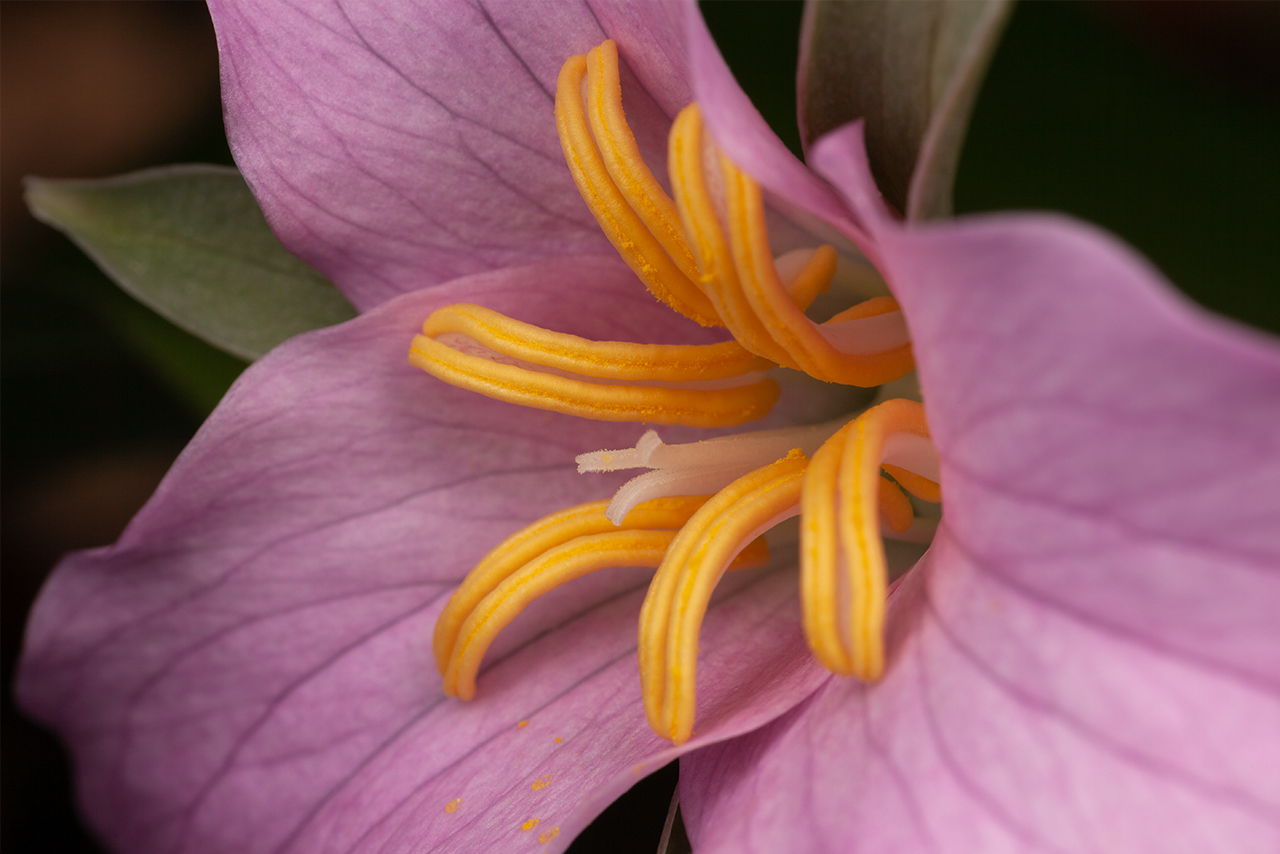
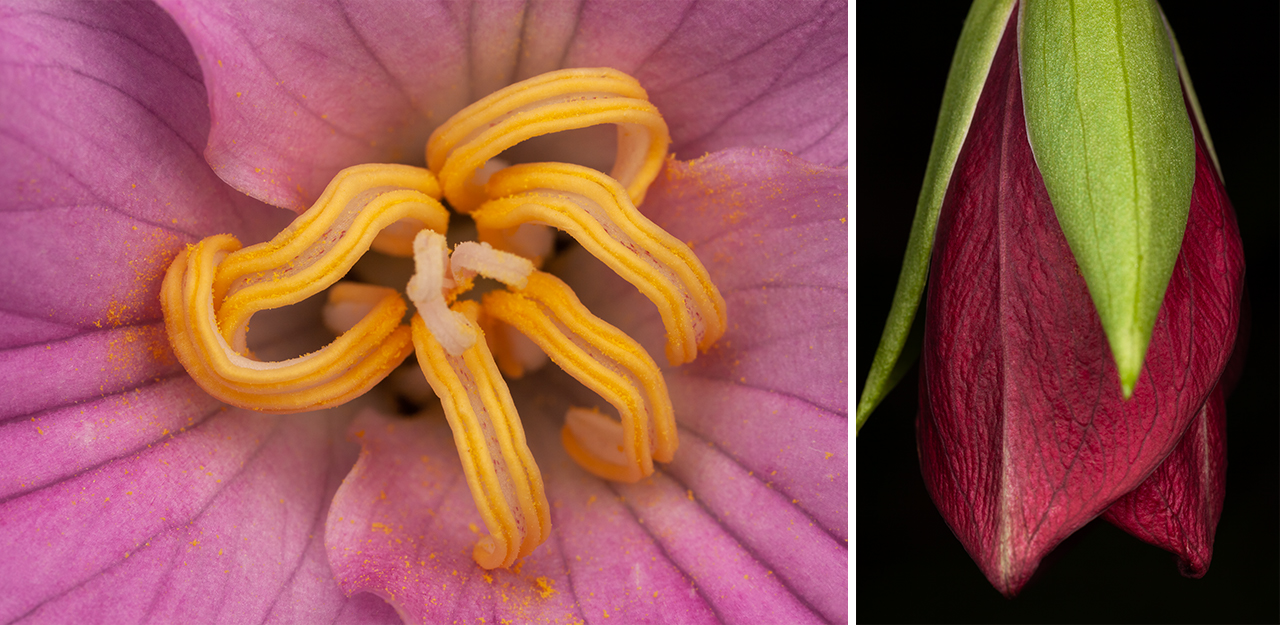
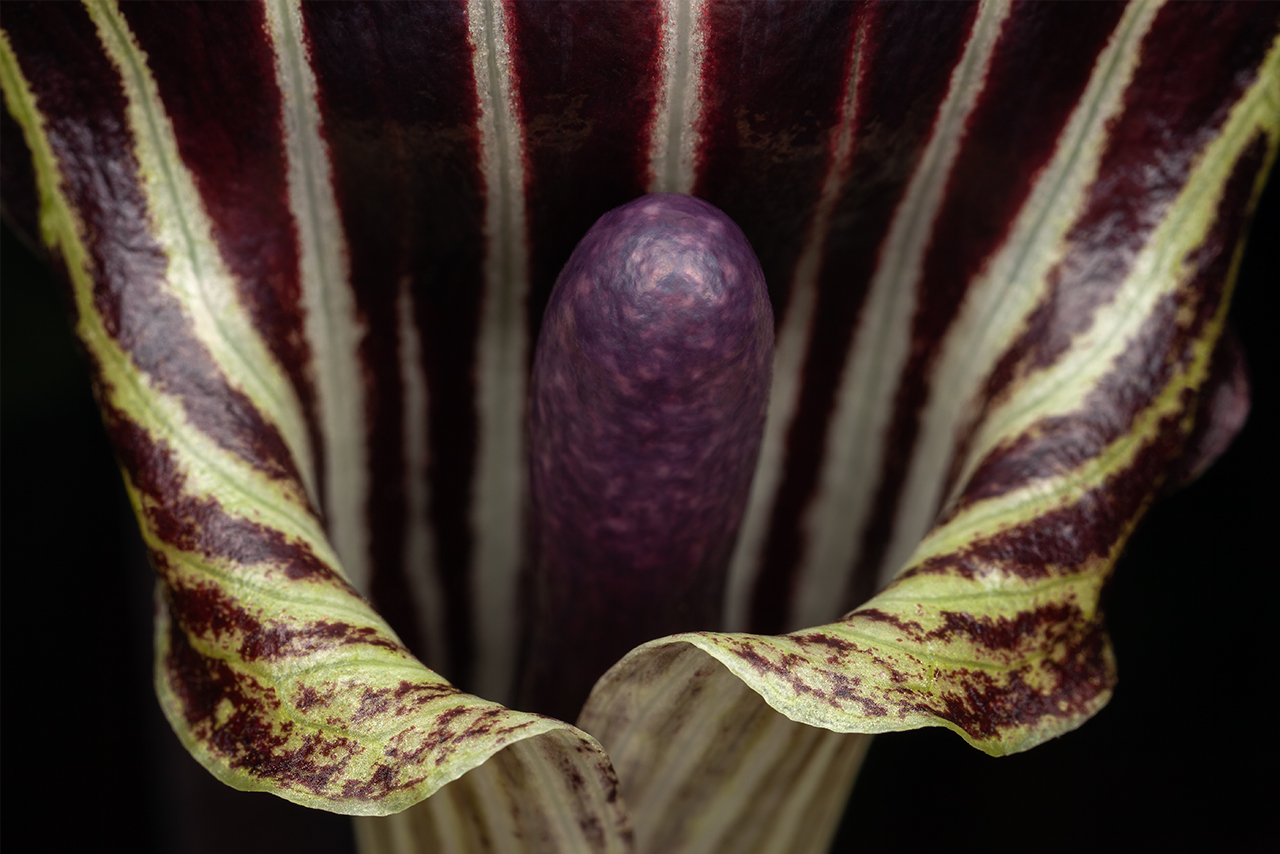
Clear and sunny skies dominate my trip to the Blue Wall this year, forcing my photography to the edges of each day. I wait atop a large boulder along the Chattooga River for the sun to slip the tree line. While running with my client last week I noticed a compositional opportunity that I’d like to work through this evening. A keyhole-like cutout in the river rock–as well as a strategic little fern–together provide a beautiful lead-in to the main rapid, Bull Sluice. I decide, while waiting for the light, that I want to eliminate as many distractions as possible. Instead of showing the far riverbank, forest, and/or sky, I punch in on just the rapid itself, trying frames both with and without foreground.
These two images would hit my shortlist for favorites on this trip.
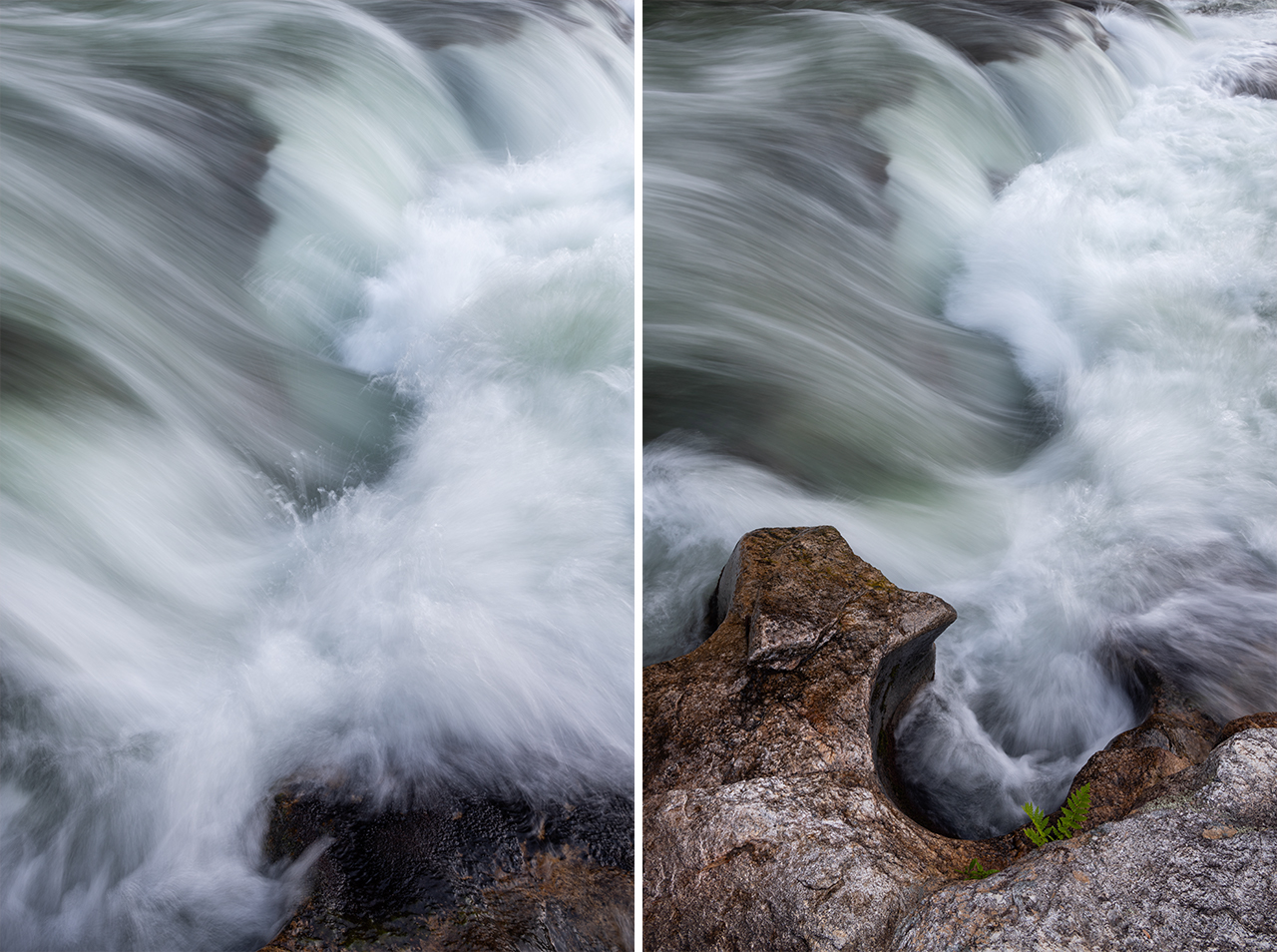
Day eight: April 28, 2022
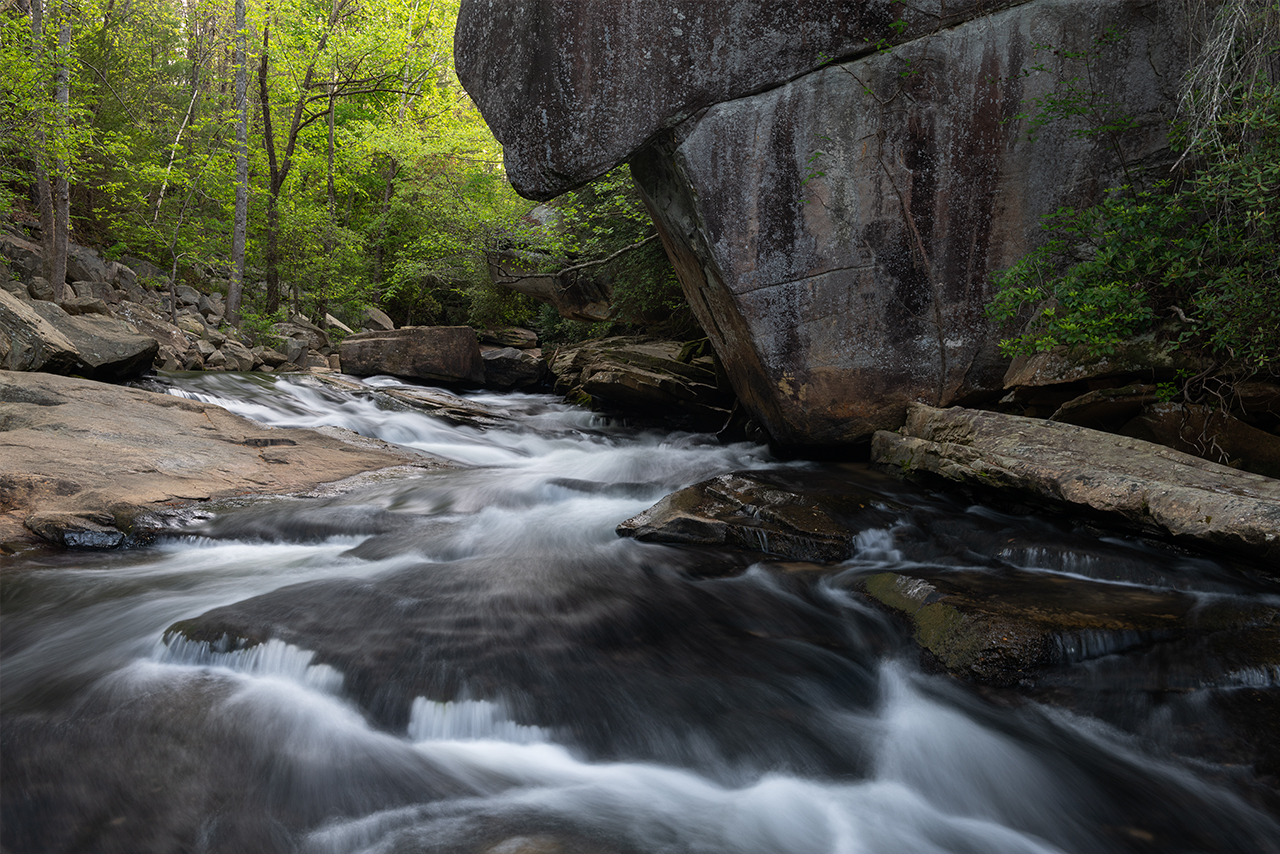
Being in the right neighborhood (and feeling a bit aimless), I decide to point the car away from the mountains and head inland towards a granitic flat rock that should be sporting some unique blooms. I visited about a week ago and things were just getting started. Today, the Elf Orpine blooms are looking thick and plentiful.
For the past couple years I’ve struggled to capture these little guys! The late great Jim Fowler turned me on to Elf Orpine and friend and photographer Susan Stamey helped me to find the site. The physical makeup of Elf Orpine and their proximity to each other (they grow in thick mats an inch or two off the surface of bare rock), really challenges my single-shot macro preferences. I’m a firm believer that not everything in a photograph needs to (or should) be tack sharp. The gray area is found, for me, in the decision of what and how much. I’m not sure I got any closer to figuring out the puzzle on this visit.
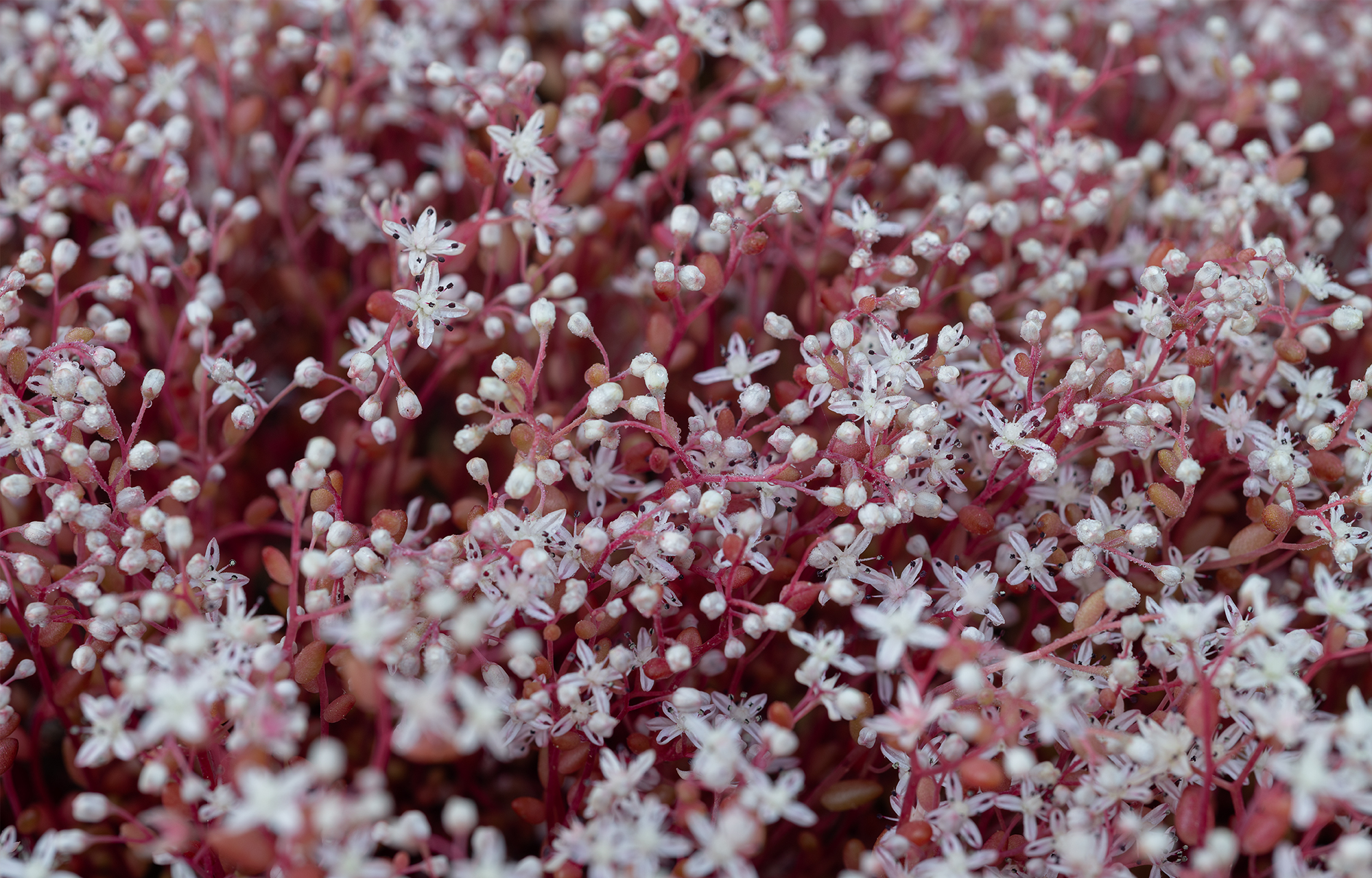
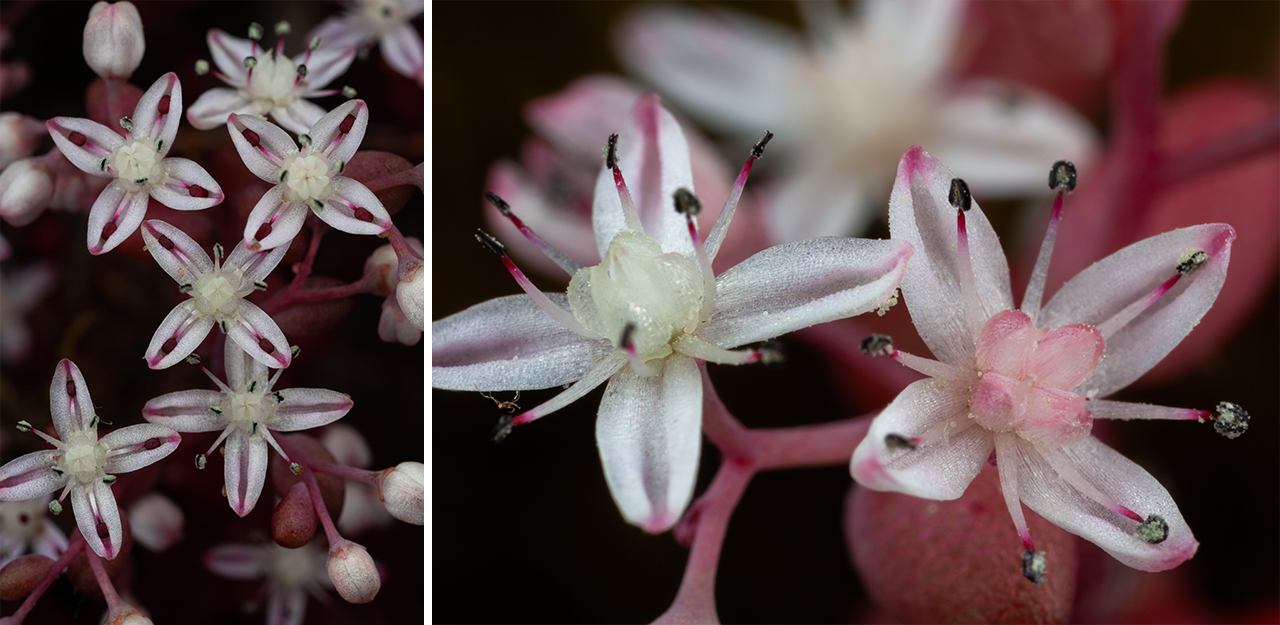

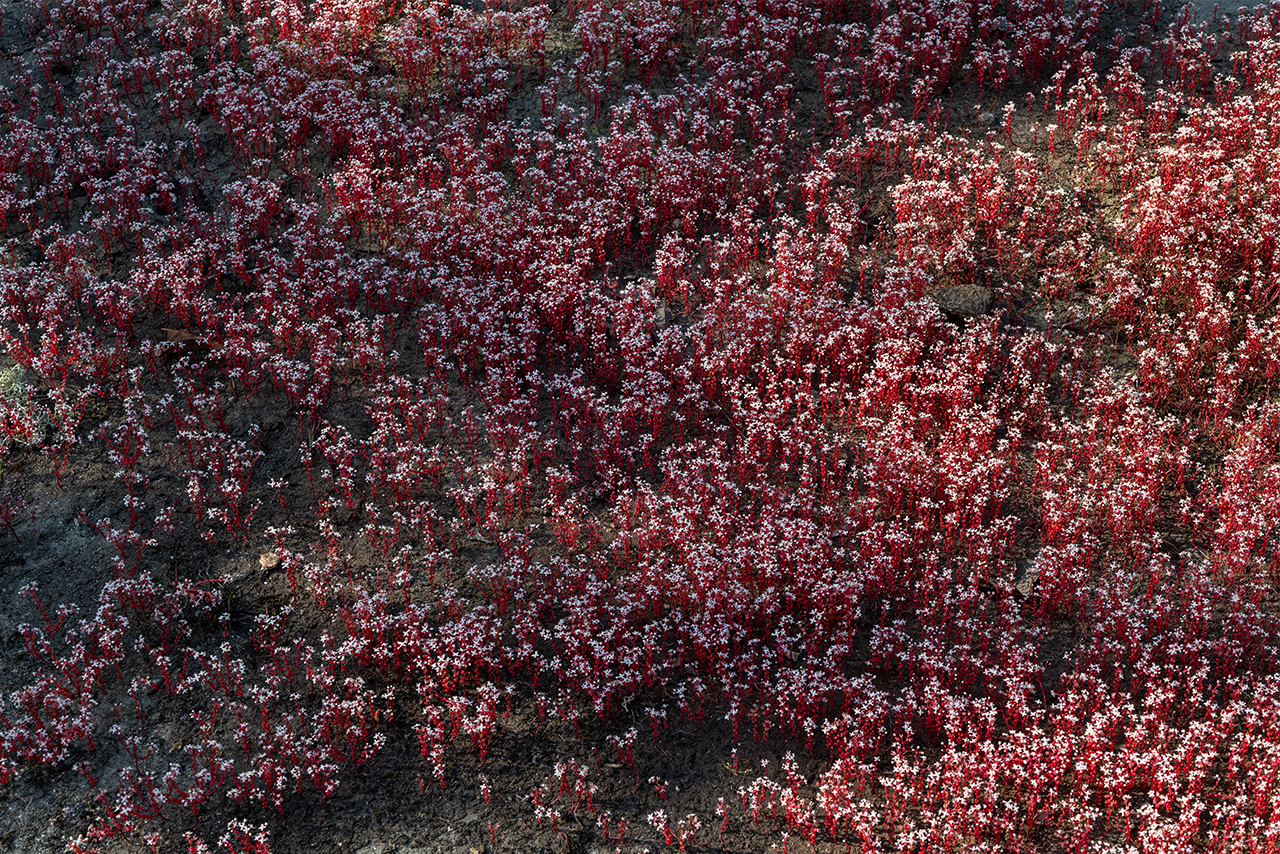

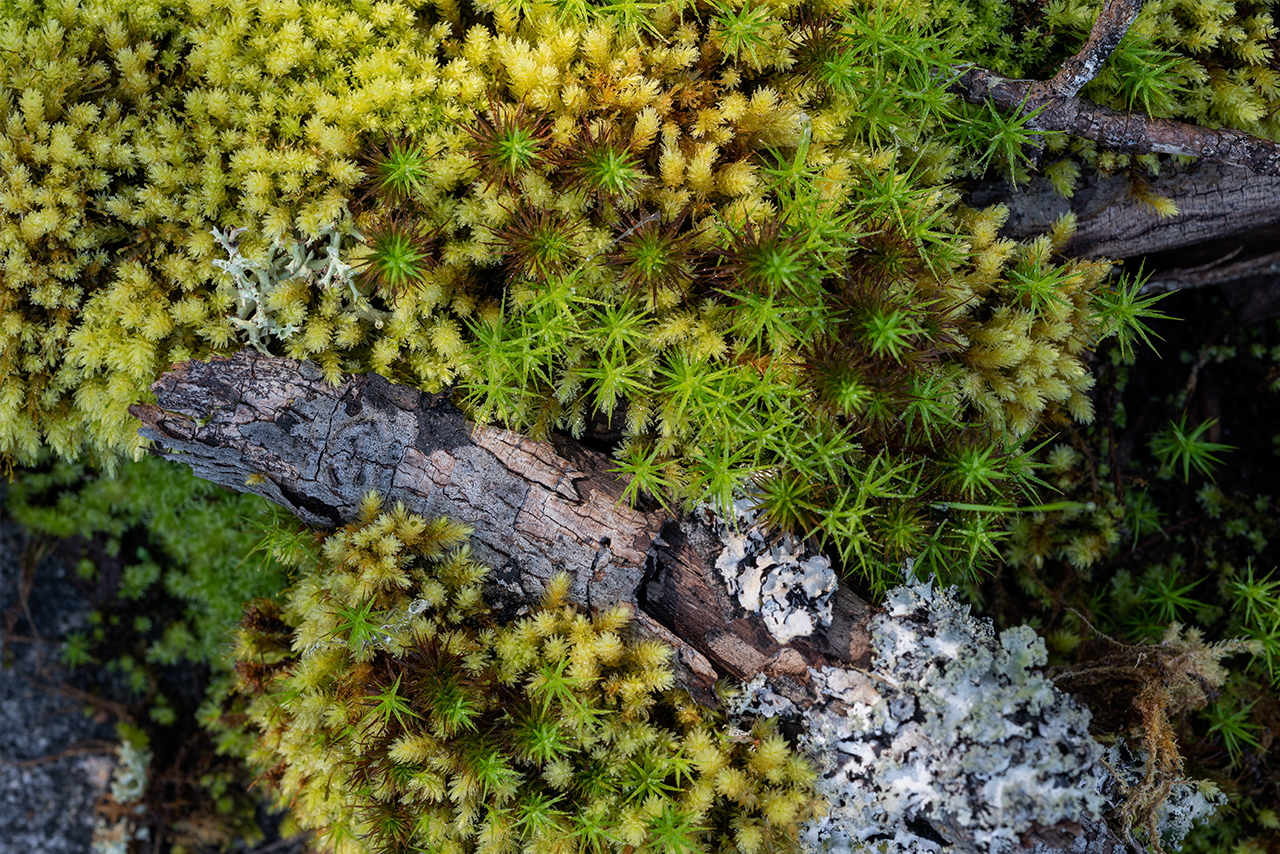

Day nine: April 29, 2022
I wake long before first light with a strong sense of purpose. The morning destination: Whiteside Mountain. Whiteside Mountain is a set of sheer vertical cliffs, the highest in the eastern United States. At roughly five thousand feet in elevation, the two-mile loop trail atop Whiteside Mountain offers an unmatched view down into the piedmont of Upstate South Carolina. The effect of The Blue Wall is unmistakable from this vantage. Unfortunately, the sky on this morning is gray and the light is flat.
No worries. I motor over to the Cullasaja River Gorge via US-64. The Cullasaja River Gorge is a dramatic seven mile stretch of river with many waterfalls and cascades just outside of Highlands, North Carolina. For such a small area, the Cullasaja River Gorge punches well above it’s weight class in my personal opinion. It’s hard to verbalize my disappointment when I realize, upon arrival, that spring has yet to settle into this deep, dark gorge. The trees remain largely bare. The rocks largely naked of moss. My timing is off.
Feeling deflated again, I decide to stop by Glenn Falls in Highlands on the way back to camp. The story remains unchanged: too early seasonally, consistent winds, and uninspired light. I point my car back down NC-107 towards South Carolina.
After a recharge at camp, I drive over to Burrells Ford along the Chattooga River. Grabbing the macro rig to stay light and careless, I begin to roam the Chattooga River Trail. I walk several miles in both directions. Physical movement has always been my magic elixer. It clears my mind and creates the space necessary for creativity. If you were to ask my worst fear, it’s something to do with losing movement.
Walking along the Chattooga River reminds me of my father. He’s always loved trout waters. He would absolutely love this river. I think of him as I walk. He’s somewhere back in Virginia riding a desk so I can live this opportunity. I feel anxious knowing the sacrifices that both he and my mother have made for me. I wish that what I did–my photography–was somehow more meaningful.
I snap back to the moment when I begin to notice Pink Lady Slippers in great quantity. I count several dozen along the trail. Some are deep shades of magenta. Others are almost white. The disappointment of my failed morning efforts fades. New opportunities demand my attention.
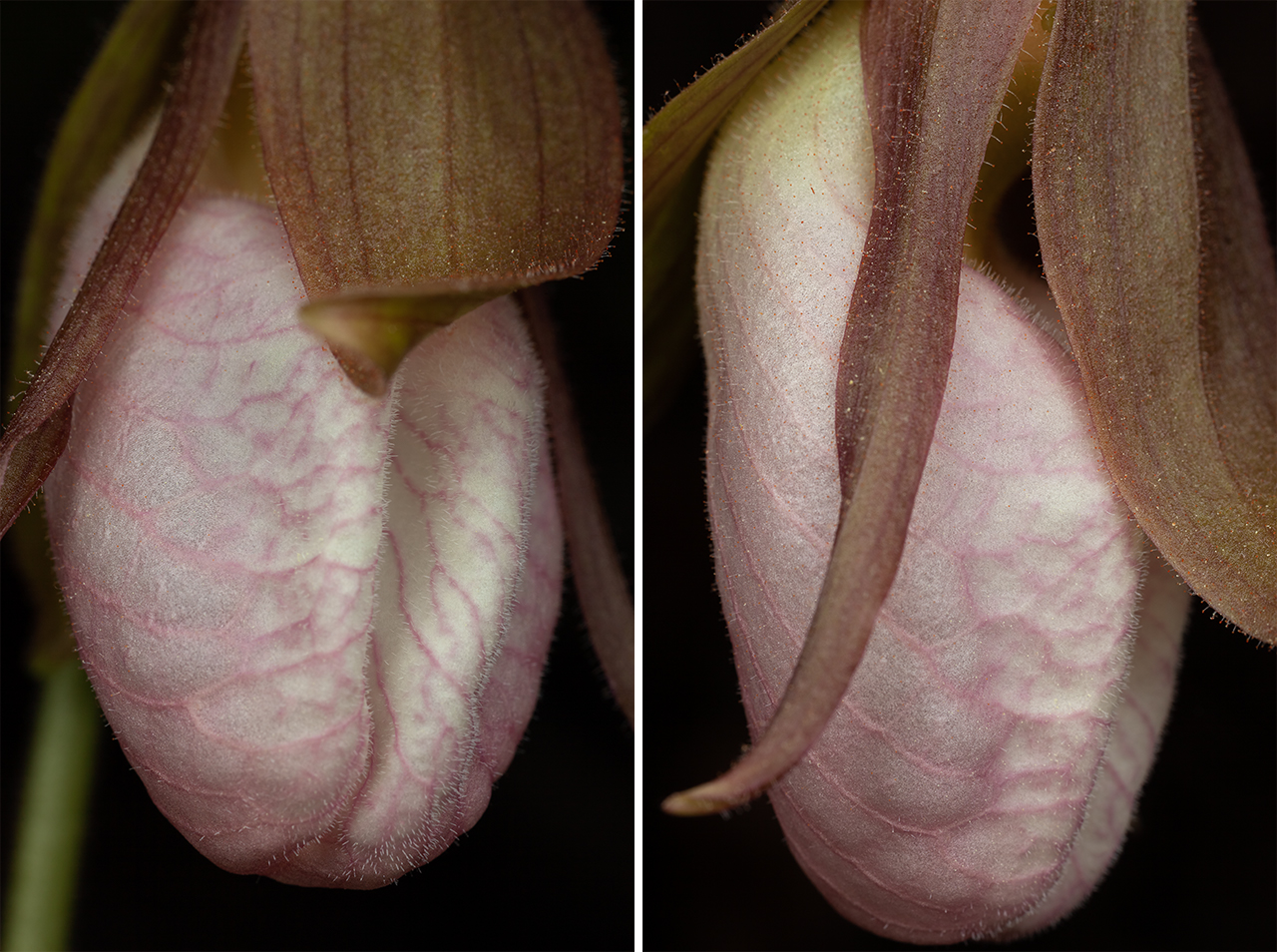
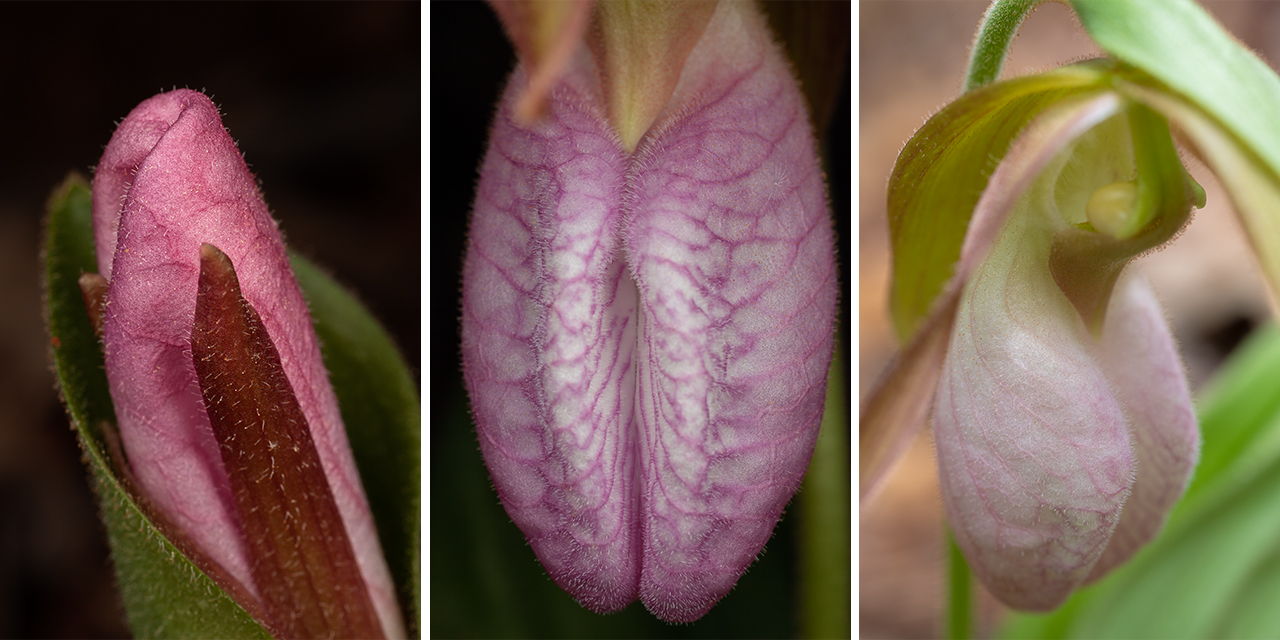
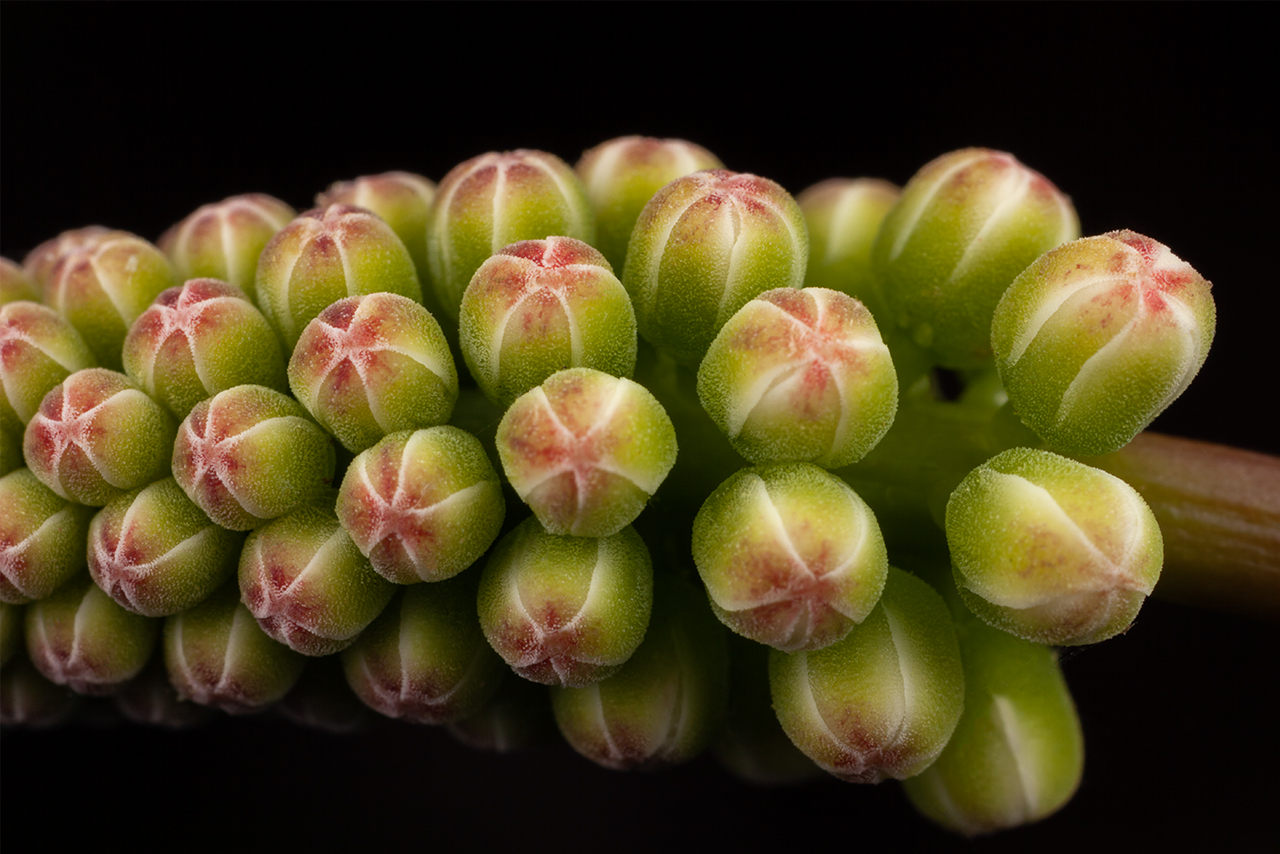
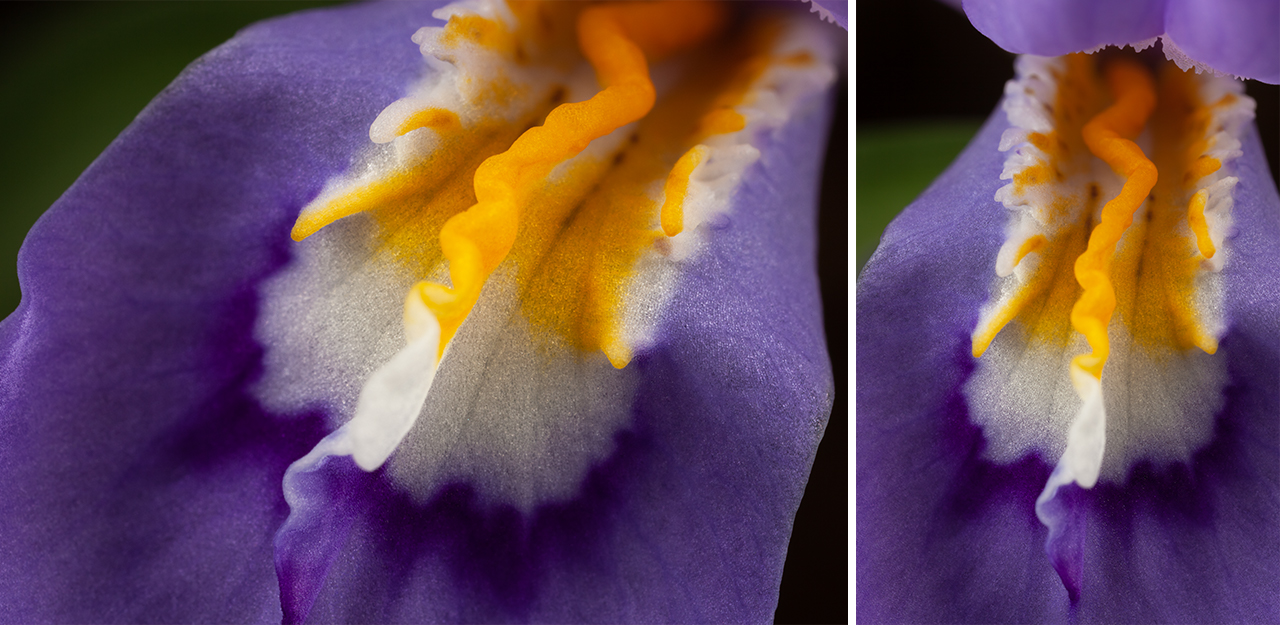
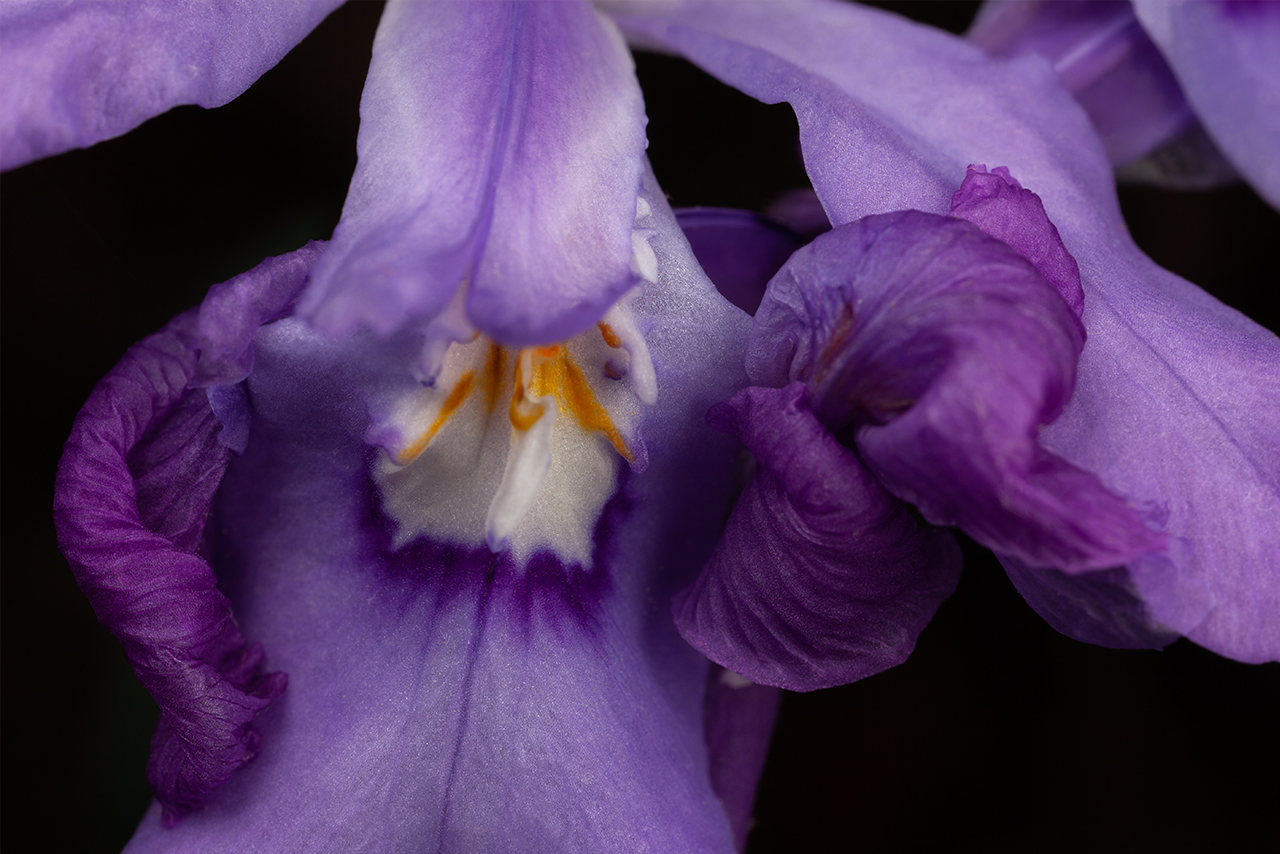
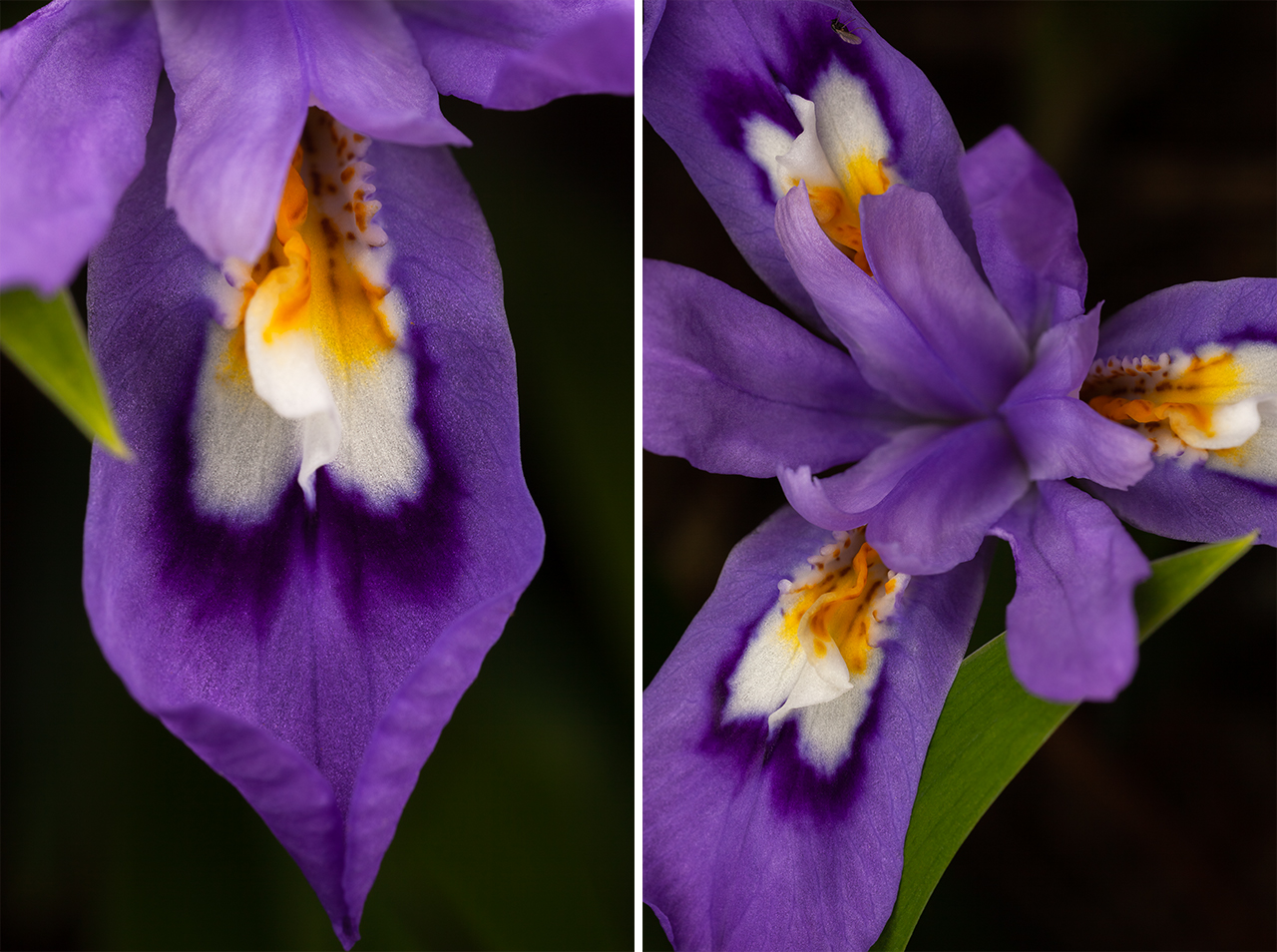

Day ten: April 30, 2022
We arrive onsite early in the morning and are immediately greeted not twenty yards down the path with a handful of perfect slippers. We soon realize that this location is absolutely overrun with blooms! I’ve always wanted to find “groupings” of pink slippers and not far into the hike we’re on pairs and trios in beautiful shape.


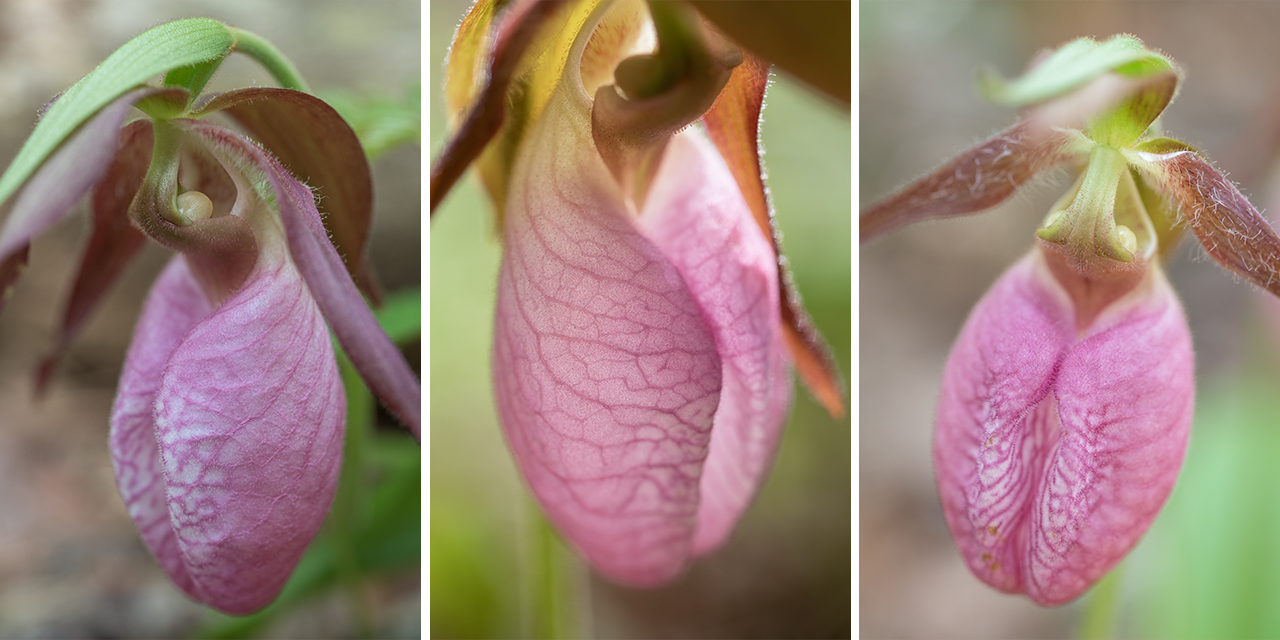
The dark, damp space underneath the curtain of water appears to be full of growth. As I get closer, I see little vascular plants that I’ve always found fascinating: Cats Tongue Liverwort! The texture and color is very expressive to me. And, if you have some extensions or a lens that can get you greater than 1:1, the little individual air pores are super neat as well! I didn’t bring my 1-5x lens on this trip and I’m regretting it at this moment.

From the waterfall, Susan and I check in on a famous Poplar Tree off Rich Gap Road. Standing at roughly 130 feet high and boasting over 400 trips around the sun, this Poplar is the second largest in the state and one of the three largest in the entire country.
We continue from the Poplar Tree up into Highlands to visit the Highlands Botanical Garden and Biological Station. Trillium, late blooming Oconee Bells, and Pinkshell Azalea greet us throughout the property. There’s even a few fading Swamp Pinks…one of the plants I’ve been trying to catch in the wild for a few years now.
Before heading back down to camp and parting ways, we take a late lunch at Mountain Fresh Grocery in downtown Highlands. The House Burger is a beautiful monster! Luck grants us an outside table along mainstreet. Business is obviously good; a steady stream of customers turn the tables throughout.
Back at camp later that evening I decide to make the short drive up to Burrells Ford along the Chattooga to see Spoonauger Falls as the light descends. I find myself pulled, once more, to the many small plants that populate this trail.
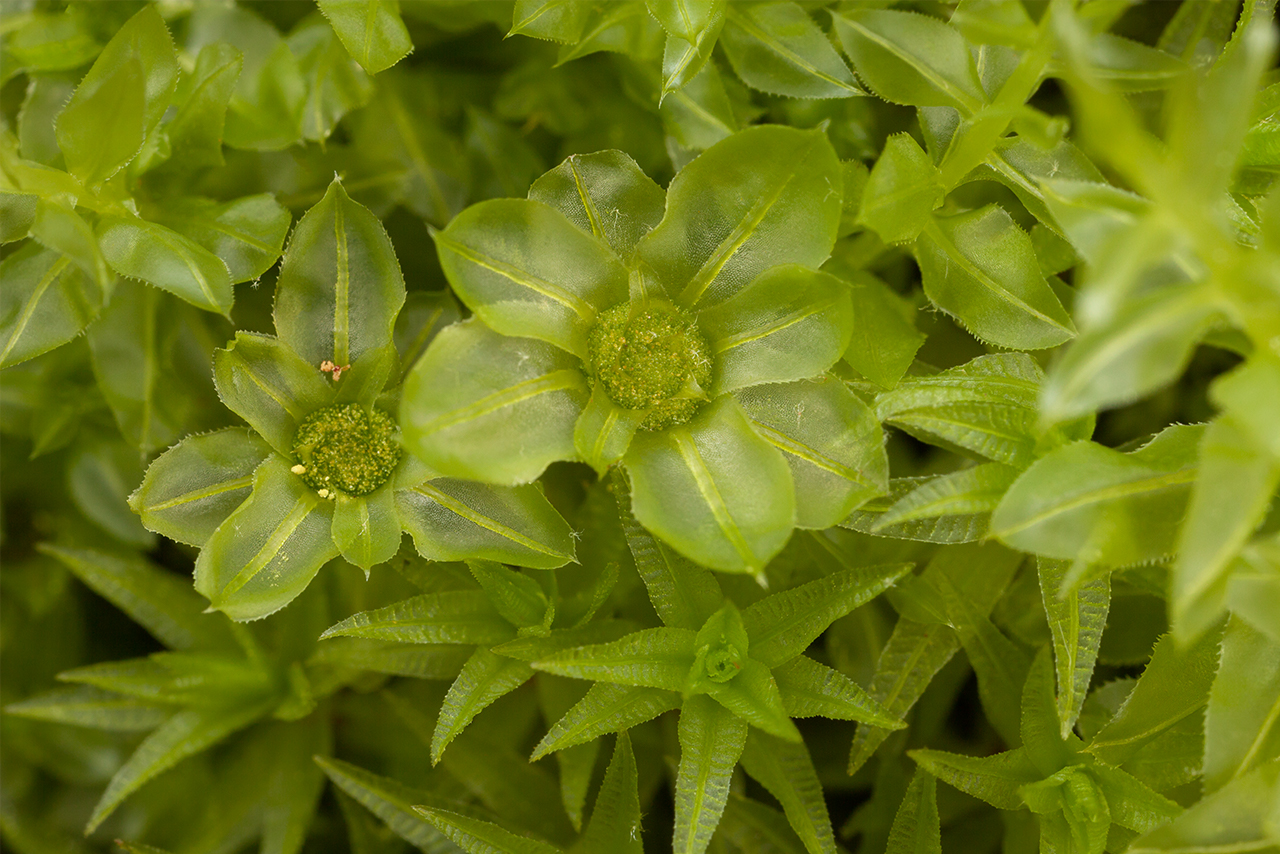
Day twelve: May 2, 2022
What happened to day eleven (May 1, 2022) you ask? I took a zero day. The primitive camping area was pretty lively the previous night. I think it might have been a girl scout troop that reserved the majority of the sites around me. By 10:00am in the morning (Sunday), however, the entire primitive camp area was a ghost town. Folks packed up and returned to the responsibilities of work-week life.
So, on the first day of May, I slept in and spent most of the day reading. Zero days are really important to me. As I’ve gotten older, my motor (both physical and mental) requires more attention. To stay outside longer (and to stay passionate about doing so), I’ve found, for me, requires short and relatively frequent periods of down time. I usually just grab some fluffy fiction, raise my feet in a zero gravity chair, and pass the day with my face in a book.
May 2nd was my last day scheduled to work The Blue Wall in spring of 2022. My destination: a slot canyon in the Upper Chattooga River watershed. The first time I discovered this place nearly twenty years ago was by accident. The area was experiencing a prolonged and extreme drought. Water levels were very low. One of the most exciting things for me, at the time, was walking rivers. And so, I literally walked right into this unique landscape feature upon my first introduction!
Today, however, is not as graceful! I scramble up, over, and down enormous rocks. I lose traction and slide down an angle of decline that leaves me boots on in the water. But, eventually, I make it into the mouth of the slot canyon. At this location, the Chattooga River necks down to a few feet in width, mysterious and dark in its depths. The stone walls resemble rollercoasters of erosion and river current. I have no doubt that there’s a phenomenal frame to be found within this unique space. Today, however, would not be the day.
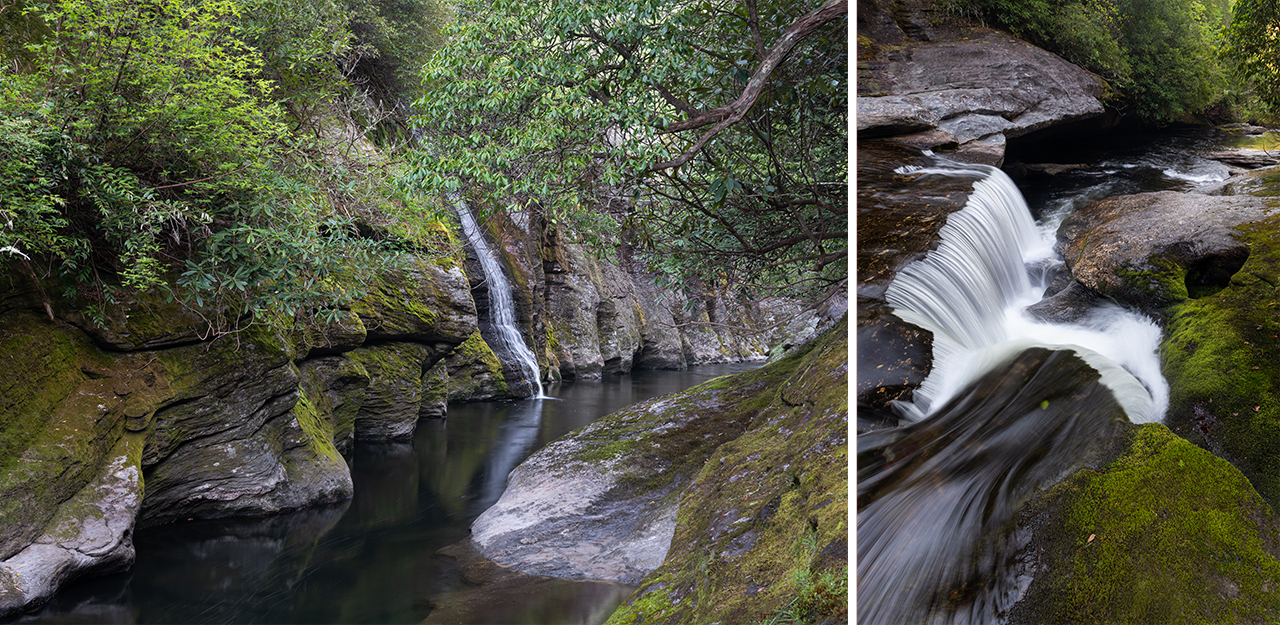
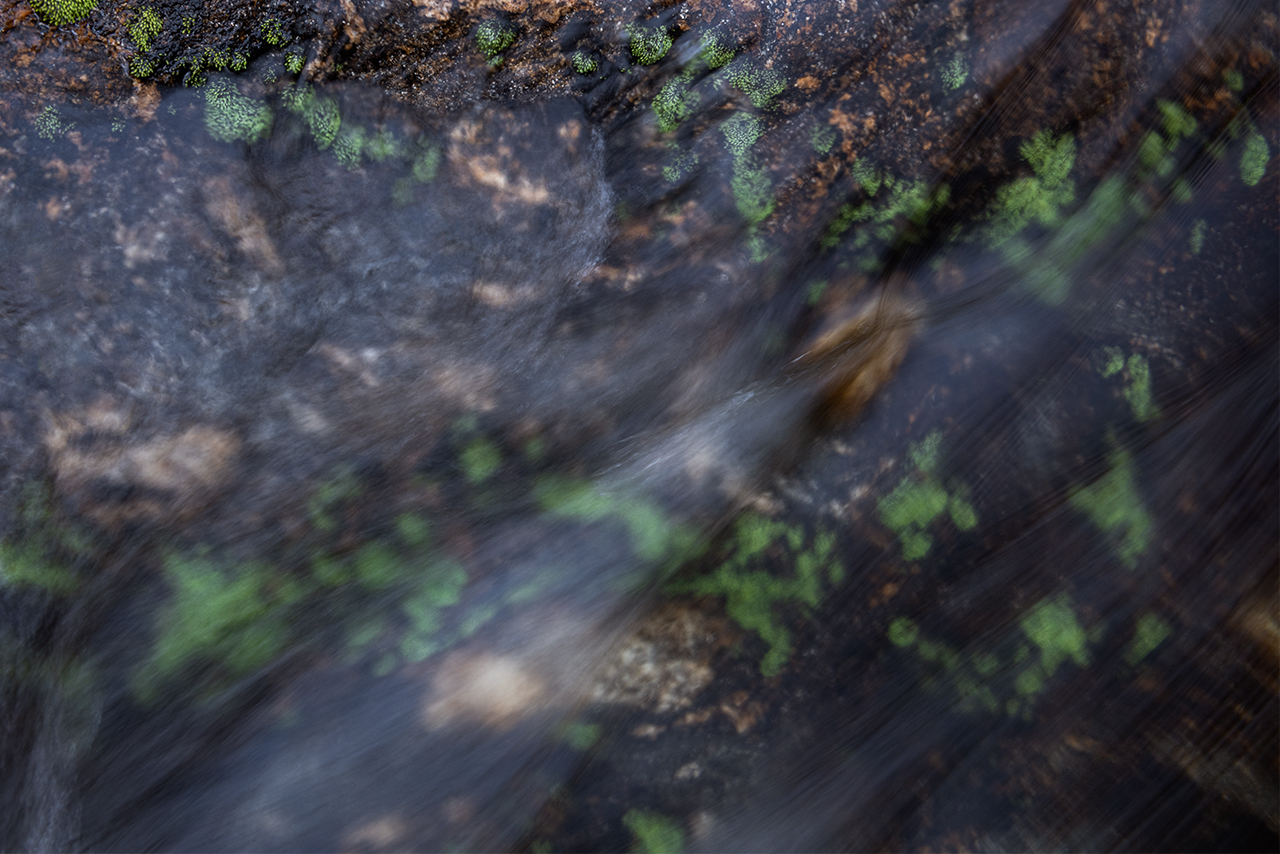
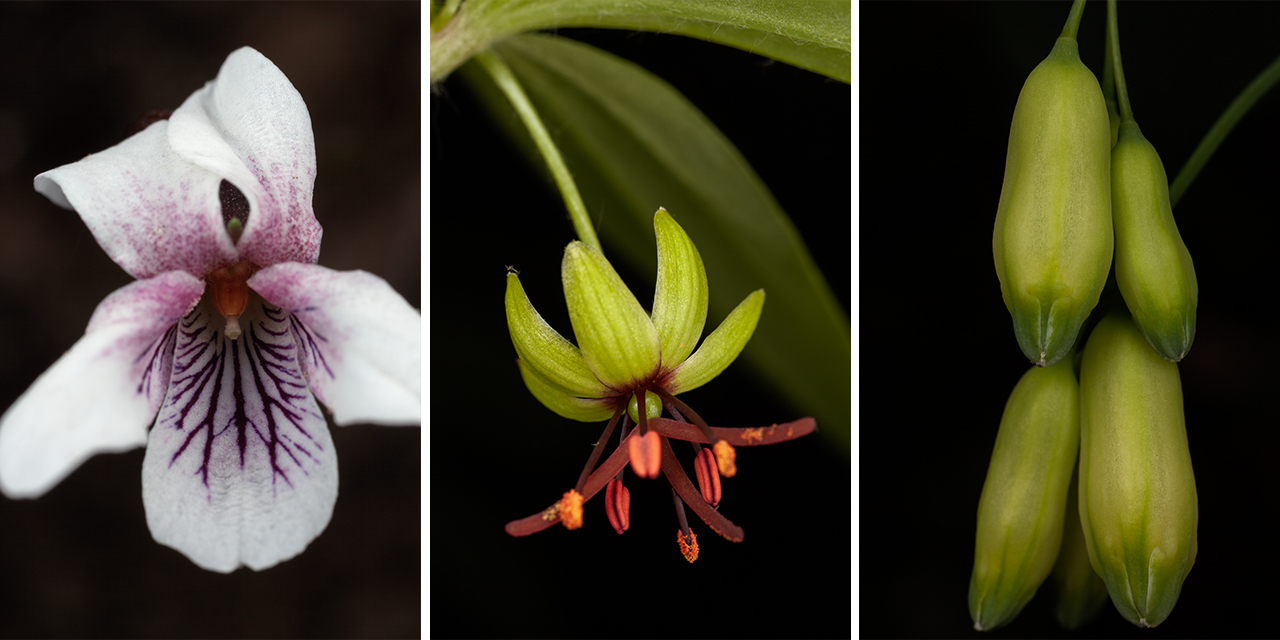
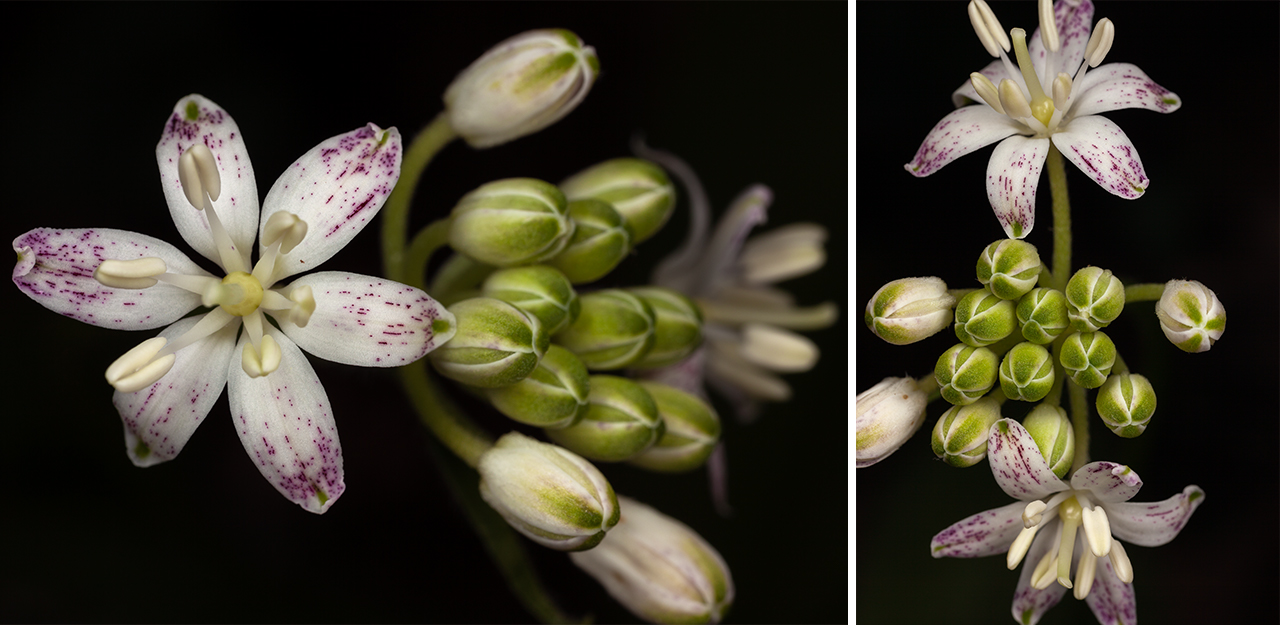
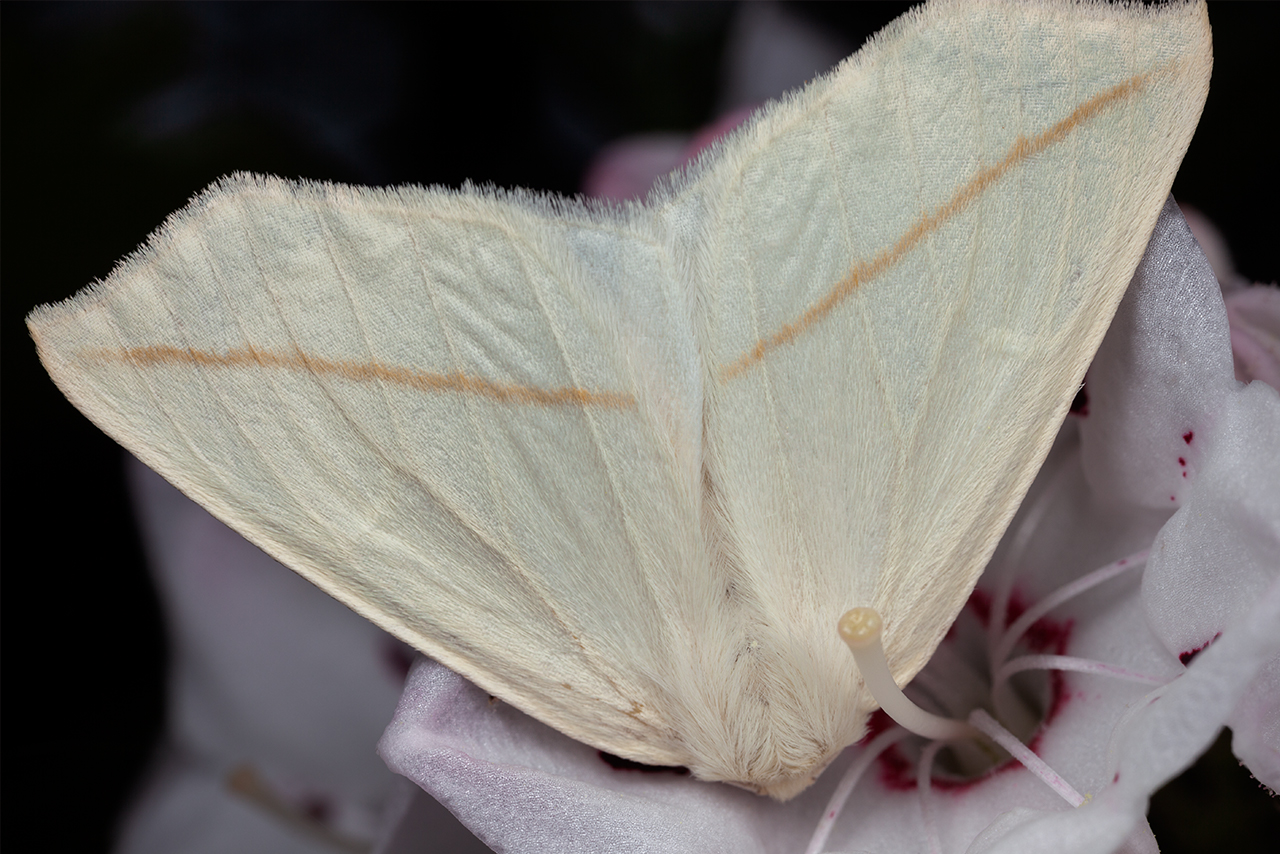
(Above): White Slant Moth on Mountain Laurel Bloom, Oconee State Park, SC.
Day thirteen: May 3, 2022
Moving day! I’ve been sleeping on the same gravel square for fourteen days now. I’m excited for change. I’m up at three am to quickly break camp and hit the road. My headlights cut the darkness as I guiltily creep as quietly as I can out of Oconee State Park, hook asphalt, and point towards the high mountains. Before long I’m dodging opossums and collecting insects on my front bumper as I navigate dark, characteristically curvy highways through Western North Carolina.
I’m at Graveyard Fields along the Blue Ridge Parkway well before first light. I take sunrise from Black Balsam. My primary aim with this leg of the trip is to capture Pinkshell Azalea, a rare shrub found only in a few Western North Carolina locations. It doesn’t take long, however, to realize that I’m too early. The shrubs are full of buds, but flowers are scarce.
I try an unnamed ridgeline trail with fingers crossed and find my secondary subject in this area: thousands of flowering yellow Trout Lilies. There’s no way to work these little guys without getting down on their level. I spend the next several hours on my stomach and sides, inching forwards and back, combing the forest floor for unique blooms.
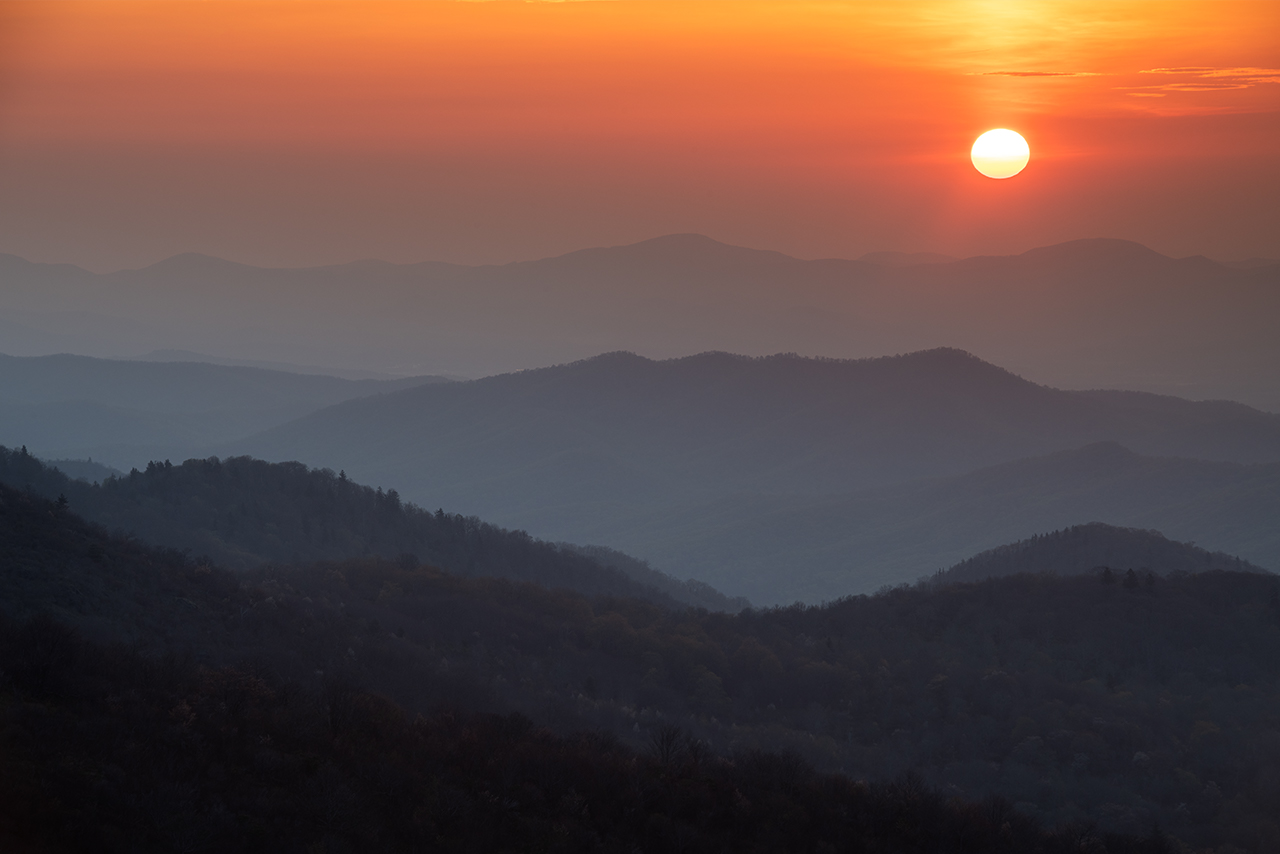
(Above): Sunrise over layered mountains as seen from Black Balsam.
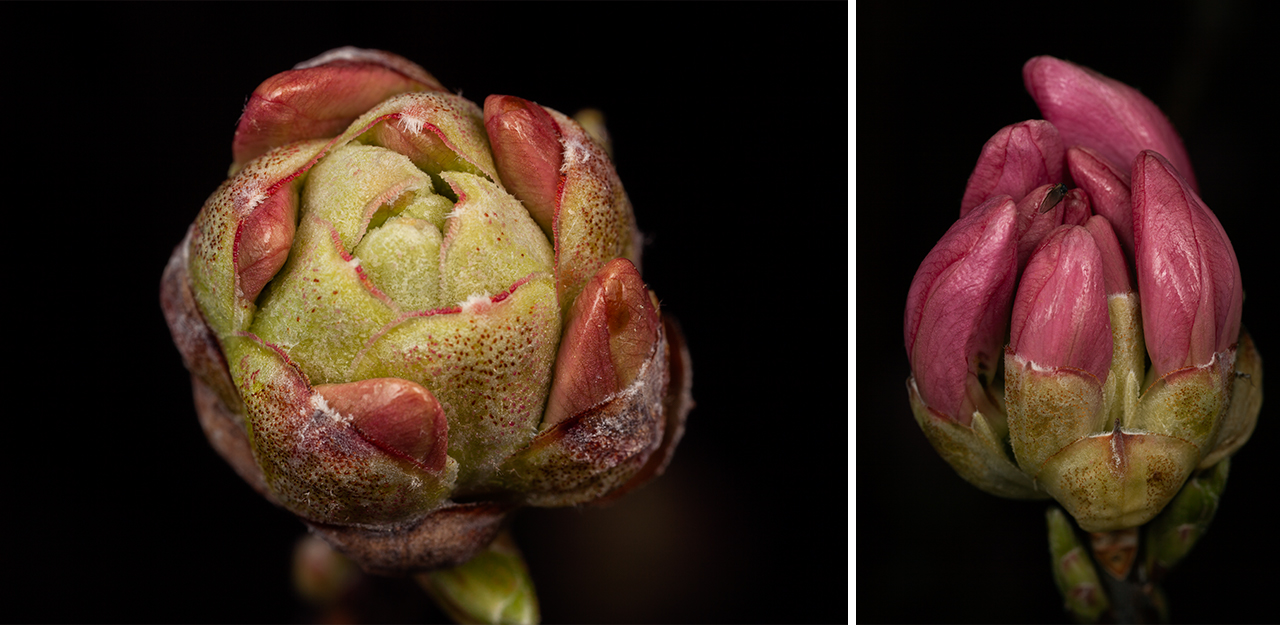
(Above): Early Pinkshell Azalea buds along the Blue Ridge Parkway.
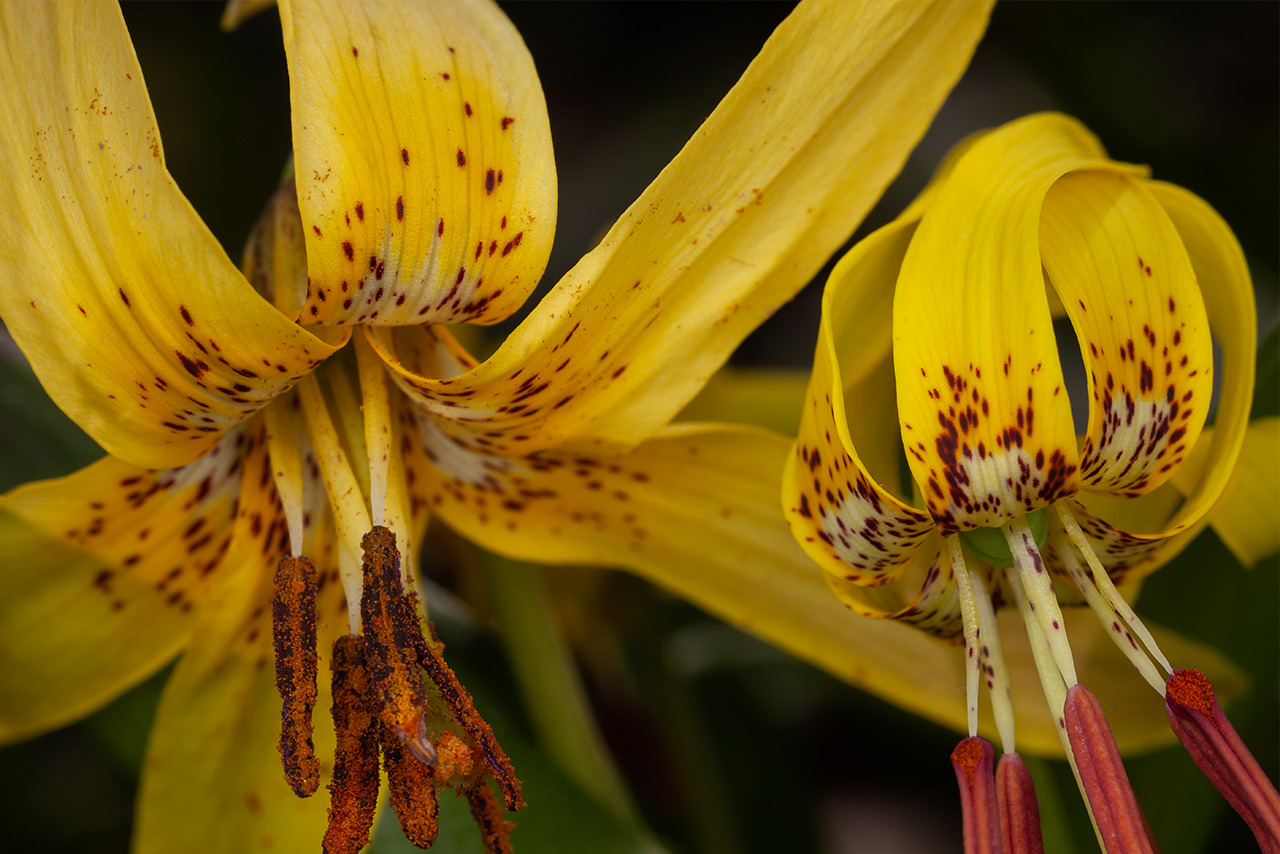
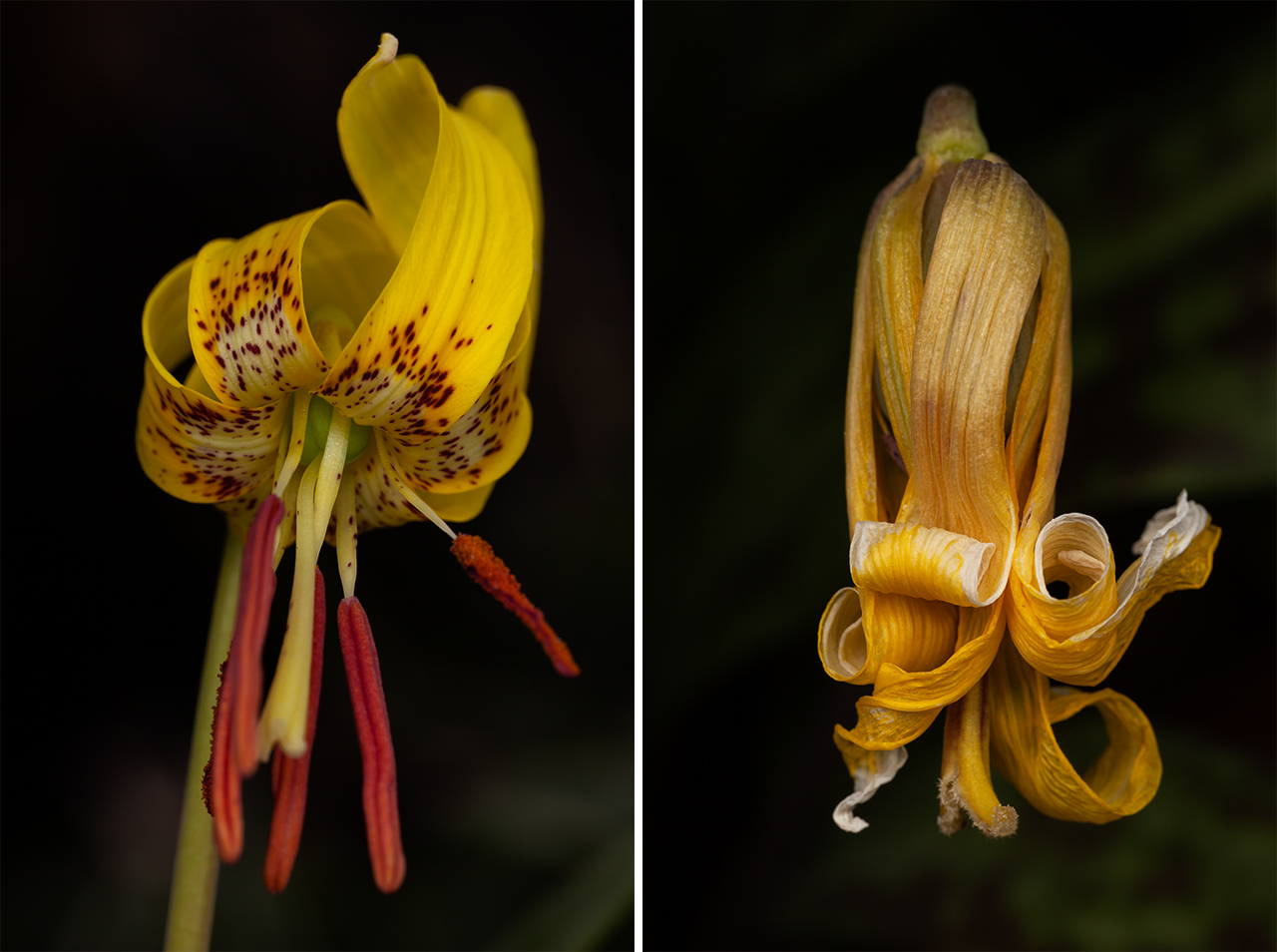

(Above): Yellow flowering Trout Lily blooms near Graveyard Fields.
Driving the Parkway in early spring is magical, for me. Unlike the thick growth of summer, early spring allows me to spot rich cove forest as I pass. Rich cove forest is said to be some of the most species rich forest one can experience. Adjacent slopes and tall trees moderate wind and rain, while also providing deep shade. Soils are often less acidic and more nutrient rich. It’s possible to encounter a dozen species of plant in only a few footsteps. I can easily spend an entire day crawling one of these moist, steep hillsides; the discoveries always excite me!
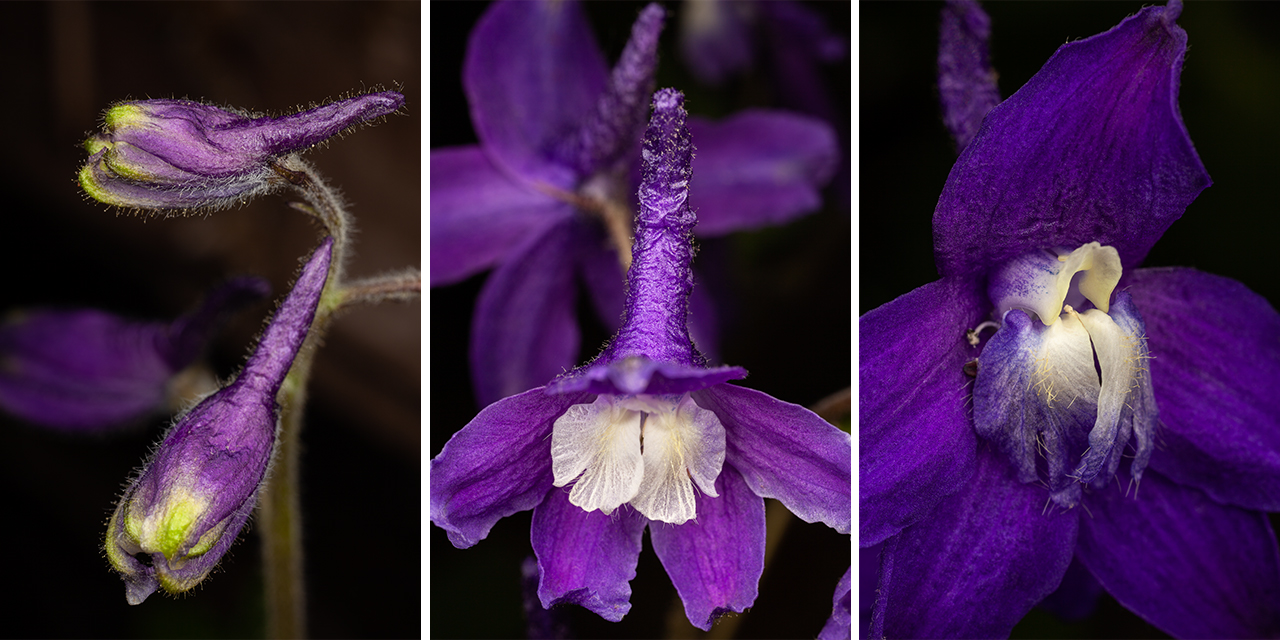
(Above): Flowering Dwarf Larkspur along the Blue Ridge Parkway.
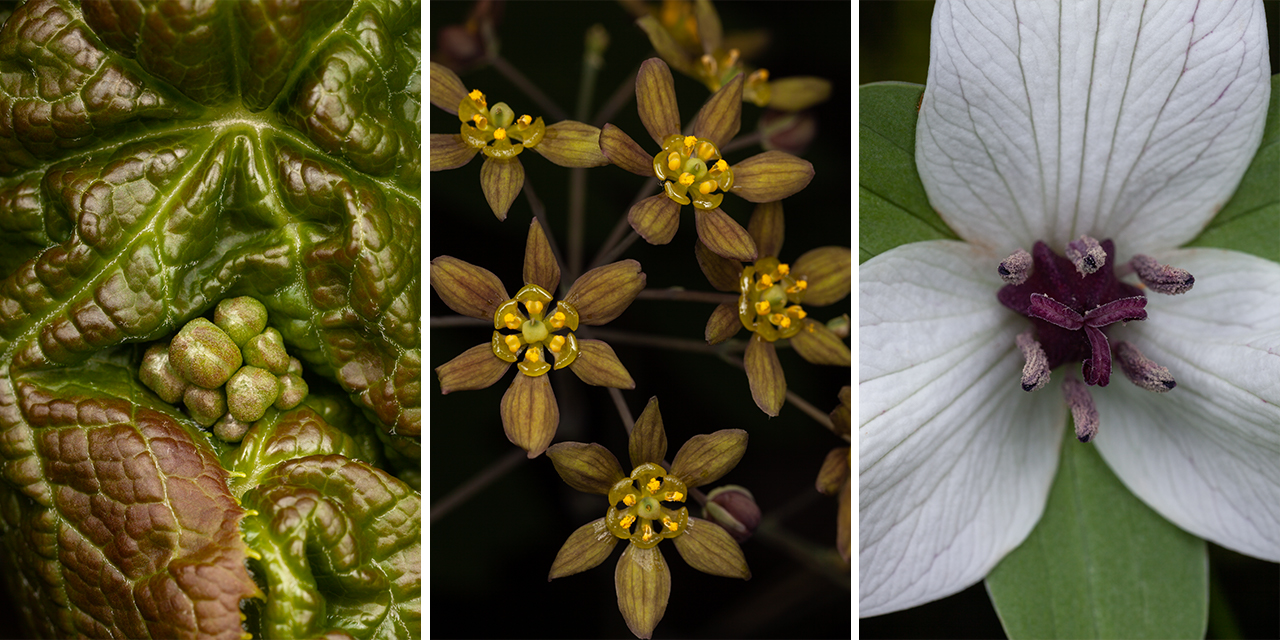
(Above left): Umbrella Leaf with buds; (above center): Blue Cohosh flowers; (above right): White color form of Wake Robin Trillium?
I turn back towards the north after finding and photographing the Dwarf Larkspur. Before I drop the mountain via US-276 Pisgah Highway, I make a short side trip to Mount Pisgah Campground. Though the facility is closed for the season, I park across the street at the hotel and walk in. From past experience, I know that the campground is a perfect location for Painted Trillium. I’m not disappointed. In fact, I run out of battery before I’m finished with the effort!

(Above): Flowering Painted Trillium.
Day fourteen: May 4, 2022
Thunderstorms along the stream at Davidson Campground overnight provide ambiance: thick raindrops hit my tent like rain on an umbrella, drowning out any other noise. I break camp just before dawn and make the short, winding drive back up to the Blue Ridge Parkway. My hopes for fog and atmosphere quickly fade as predawn illuminates the landscape. I do what I can behind the lens. It’s a forced dance of little productivity, however. I drive north.
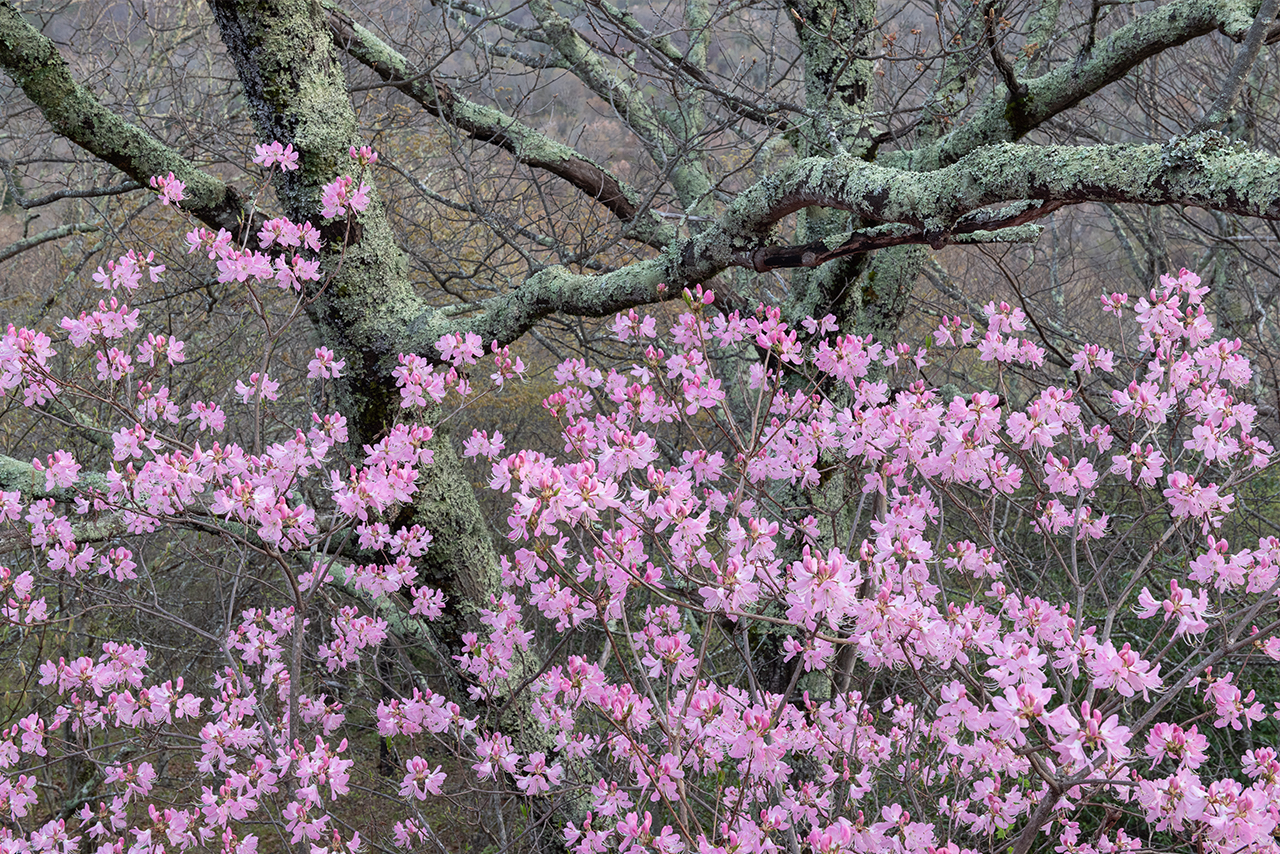
(Above): Flowering Pinkshell Azalea near Graveyard Fields along the Blue Ridge Parkway.

(Above): Uncommon color forms of Wake Robin Trillium.
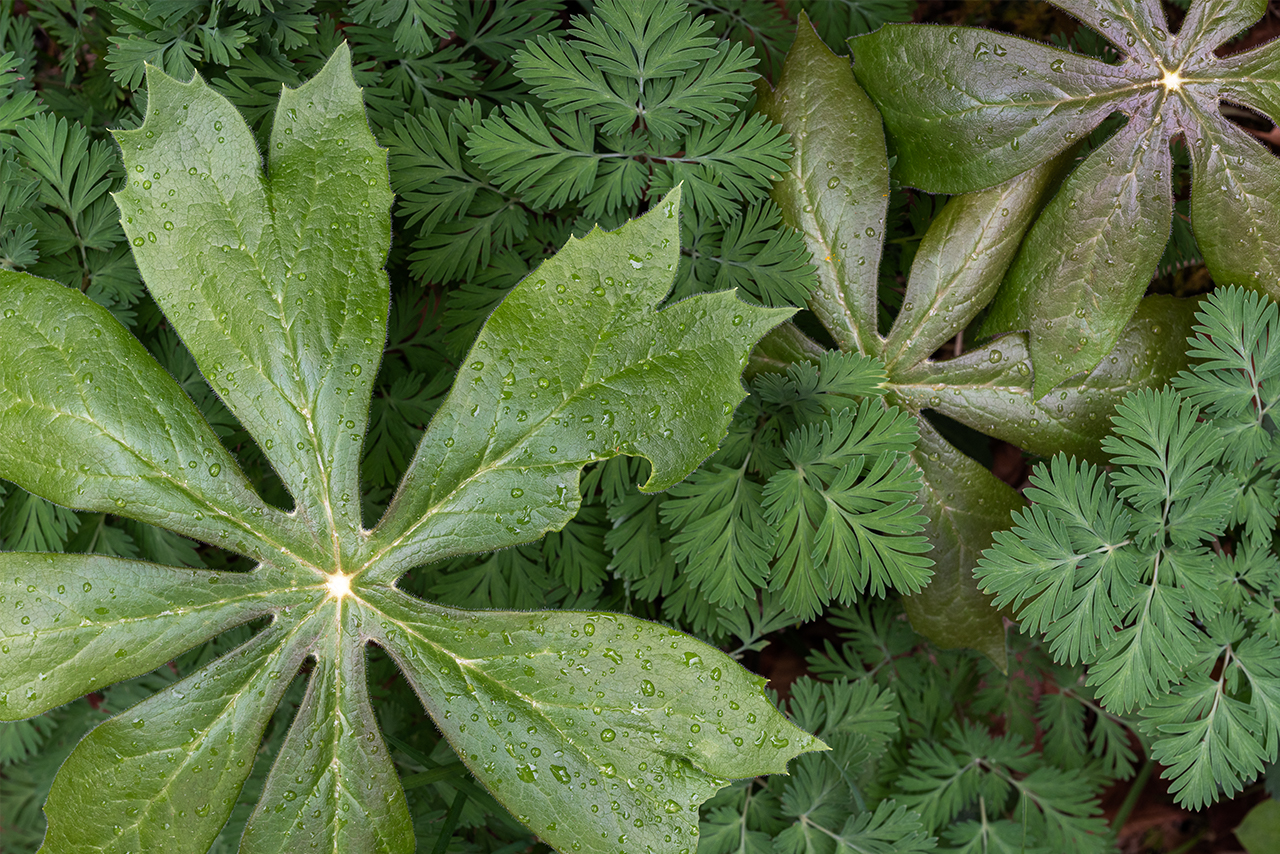
(Above): Mayapple and Dutchman’s Breeches along the Mountains to Sea Trail.
My plan is to camp at Julian Price Memorial Park Campground near Blowing Rock, North Carolina. While the federal campgrounds along the Blue Ridge Parkway do not oficially open until almost June, Price Lake is typically open much earlier. I’ve never had a problem finding a campsite during early May in almost a decade of travels.
Today, however, I’m dismayed to find Price Lake closed for the season with no indication of opening before May 28th. I had hoped to spend a week or more at this location, a series of early season flowers on my list.
With gas prices soaring, I cannot afford to get a hotel. I make the difficult and unplanned call to cancel the remainder of the trip. North of Boone, I bail on the Blue Ridge Parkway, grab Interstate 77 and begin the long slog back to civilization. It was a good trip, though. And I’ll be back. Soon.

I creatively connect people to the natural world so their attention and understanding will build and sustain its worth. Southern Appalachian Mountains and Carolina Coastlines. The land is alive. I’m called to it.


0 Comments